PAGE 08
CELEBRATING VICTORIA’S FINEST APPRENTICES
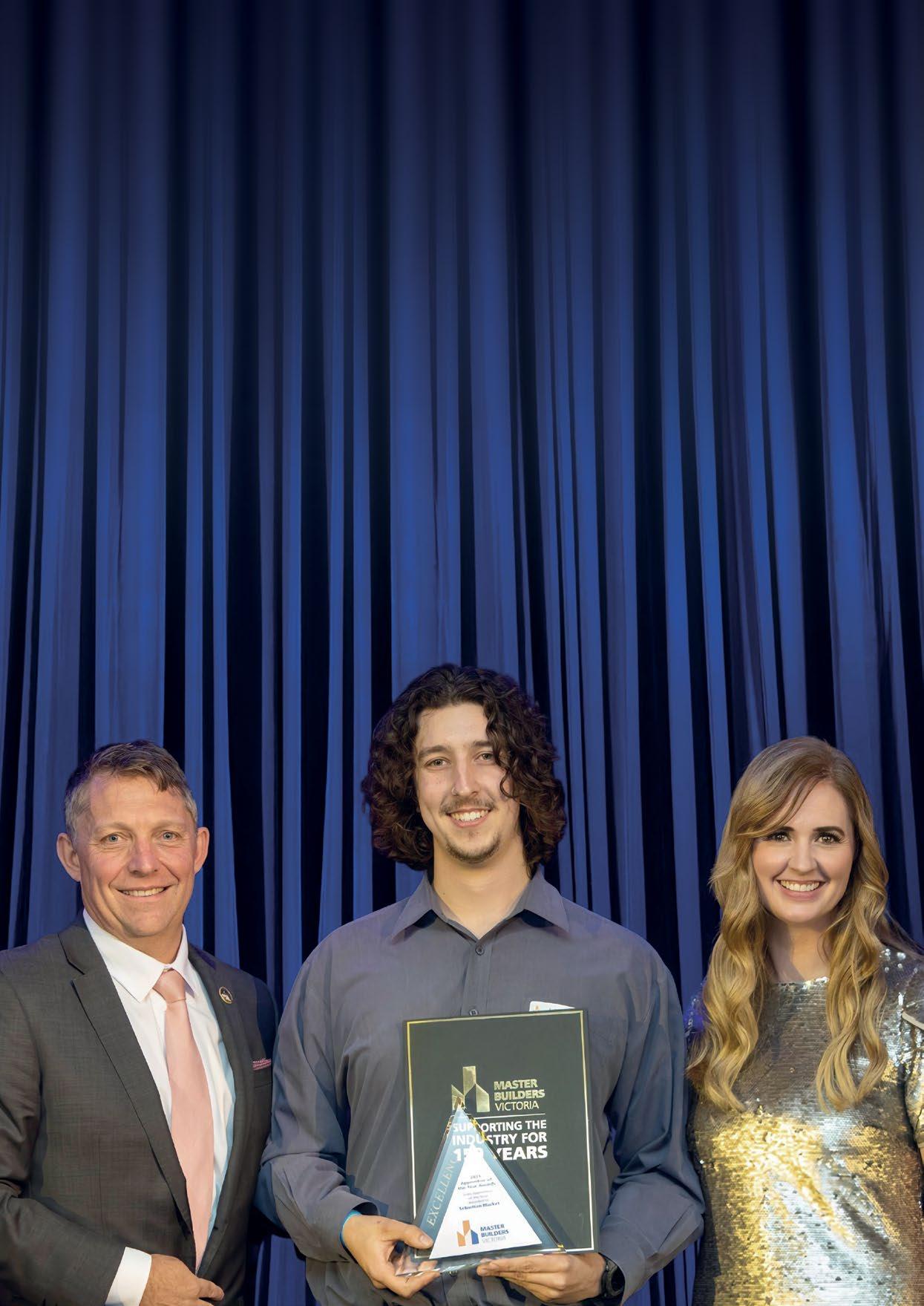

MBV LEGACIES: MORT MITCHELL
A Centenary Tribute to MBV Legend
Mort Mitchell
16


PAGE 08
CELEBRATING VICTORIA’S FINEST APPRENTICES


MBV LEGACIES: MORT MITCHELL
A Centenary Tribute to MBV Legend
Mort Mitchell
16


Scan the QR code to view MBV member discounts



















Master Builders Victoria (MBV) was established in 1875 by a group of builders intent on raising industry standards. Over this 150-year period, our organisation has grown to become the pre-eminent industry voice, with over 6,000 members.
We support members with specialist updates and advice across legal, contracts, OHS, policy, people and culture technical building, registration, and employment and industrial relations (EIR) matters, as well as providing industry connections and networking opportunities.
Not only are we a Registered Training Organisation (RTO #3935), but we proudly operate a state-ofthe-art simulated learning centre where we provide industry-leading training with our comprehensive training courses.
We believe our accomplishments are the result of maintaining our ‘members first, all the time, every time’ approach throughout everything we do.
Our purpose
Empowering people to build a better future.
Our vision
Leading a future-ready industry that builds a better world.
Our values
• Members first – all the time, every time
• Brave enough to be different
• Do the right thing, even when no one is watching
• Always find another way
Level 5, 232 Victoria Parade East Melbourne, VIC, 3002
Tel: (03) 9411 4555
E-mail: MBassist@mbav.com.au Web: www.mbav.com.au

Natalie Nicolaou
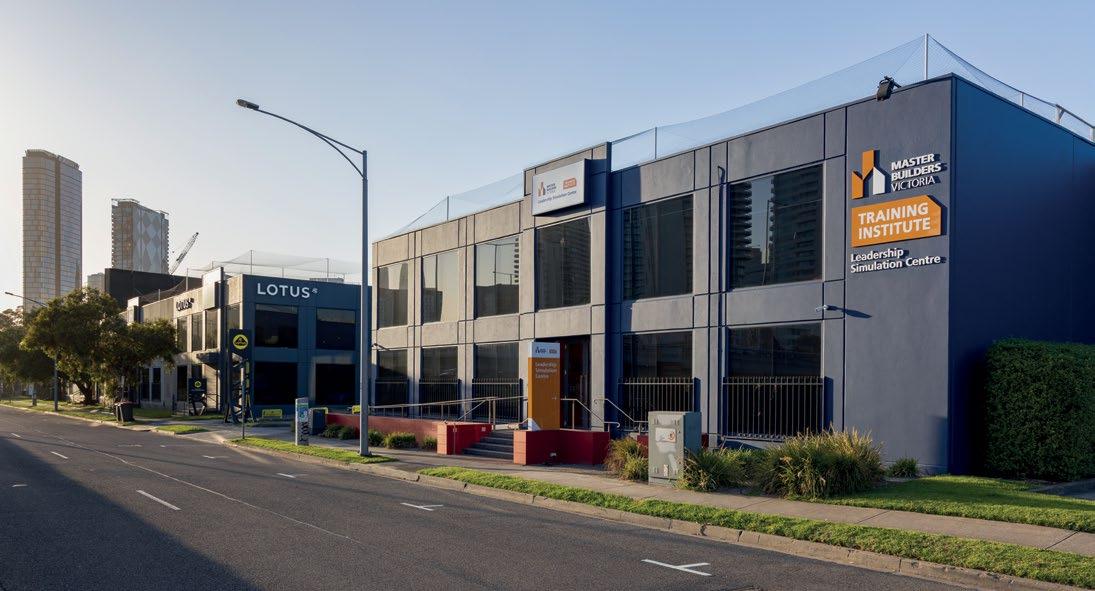
For all general enquiries, phone MBV on (03) 9411 4555, e-mail MBassist@mbav.com.au, or contact our key services using the details on this page:
Executive Team
CEO: Michaela Lihou
Executive Director, Commercial & Corporate | Chief Legal Counsel |
Company Secretary: Tristan Moseley
Executive Director, Collaboration & Innovation: Corrie Williams
Executive Director, People & Member Services: Giovanni A. Abelardo
Directors
Director Master Builders
Training Institute: Anh Tran
Director Advisory: Sam Smith
Financial Controller: Simon Thrasis
Director Policy & Industry
Collaboration: Caroline Speed
President: Geoff Purcell
Deputy President: Lisa Hollingsworth
Housing Chair: VACANT
Specialist Contractor Chair: Gregory Cole
General Contracting Chair: Matthew Gilmour
Regional Chair: Stuart Allen
MM&S Chair: Mark Phillips
Housing Sub Contractor Chair: Raymond French
General Board Member: VACANT
Regional
Stuart Allen, Gareth King, Mark Little, Ross O’Neill, Lisa Paddle, Greg Mills, James Eccles, Wade Bashaw, Steven Hedger
MM&S
Mark Phillips, Luke Hurley, Lawrence Pigot, Leon Quinn, Brenton Russo
Housing
Lisa Hollingsworth, Rebecca Bishop, Angela Perry, Nancy Italiano, Daniel Mazzei, John Goris, Nick Lonsdale, Peter Langfelder, Steven Peluso
General Contracting
Geoff Purcell, Matthew Gilmour, Michael Clemenger, Richard Hansen, Dale Kennedy, John Lehmann, Andrew Staedler, Bernie Nolan, Shayne Young
Specialist Contractor
Gregory Cole, Raff Rocchi, Mathanki Aru, Alexander Crosby, Nigel Cunniffe, Dean Dannock, Angela Stevenson,
Housing Sub Contractor
Raymond French, Howard F Hunter, Mark Flynn, Belinda Egan, Adam Rosenblum, Shane Gardner, Konstadinos Giambalkaris
Melbourne
Level 5/232 Victoria Parade
East Melbourne, VIC, 3002
GPO Box 544
Melbourne, VIC, 3001
Phone: (03) 9411 4555
E-mail: mbassist@mbav.com.au
South Melbourne
MBV Leadership Simulation Centre
49 Brady Street
South Melbourne, VIC, 3205
E-mail: trainingenquiries@mbav.com.au
35 Hovell Street
Wodonga, VIC, 3690
PO Box 700
Wodonga, VIC, 3690
Phone: (03) 9411 8070
E-mail: mbassist@mbav.com.au

Dear members,
I’m delighted to welcome you to this edition of our Master Builders Victoria magazine, where we proudly celebrate the achievements and momentum shaping our industry today and into the future.
Firstly, I extend my heartfelt congratulations to everyone who participated in and supported the 2025 MBV State Apprentice of the Year Awards, held on 8 May at Marvel Stadium. It was a fantastic evening recognising the passion, commitment and excellence of apprentices across Victoria. Congratulations to Sebastian Blacket, who was named our 2025 State Apprentice of the Year, and to all regional winners and category finalists. These future leaders represent the best of our industry, and we’re proud to champion them.
You can read more about the these awards and view photos from the event on page 8.
We were also pleased to continue the conversation about the industry’s future at our first Industry Breakfast of the year, held on 29 May. This year’s theme - Victoria’s Next Decade: Innovation, Investment, and Infrastructure - brought together government, industry leaders and MBV members for a powerful discussion about how we collectively meet the challenges and opportunities ahead. It was a timely and energising morning, and we look forward to continuing those conversations in the coming months.
MBV continues to play an active role in shaping the regulatory environment. We remain deeply concerned about the implications of the Building Legislation Amendment (Buyer Protections) Bill 2025, which has now passed through Parliament.
Throughout the legislative process, MBV advocated strongly on behalf of our members, raising serious concerns about the Bill’s practical impacts and calling for amendments to ensure fair and workable outcomes for builders and contractors. We consistently emphasised the importance of striking the right balance between improving
consumer protections and maintaining the viability of a trusted, professional building and construction industry.
Despite our efforts, the Bill introduces broad changes that we believe may create significant challenges. These include a lack of clarity around key definitions such as 'defect' and 'serious defect', limited avenues for appealing rectification orders, and a risk of retrospective liability for issues that fall outside existing manufacturer warranties, including items as minor as peeling paint.
We also remain concerned about the lack of a clear implementation framework and the absence of budgeted resources for the additional inspectors and dispute resolution officers the new system will require.
While the legislation has now been enacted, our advocacy does not stop here. MBV will continue to engage with government and regulators to press for fair application of the law, seek further clarification where needed, and ensure that the voices of our members are heard in the rollout and enforcement phases.
We thank all members who shared their feedback with us and helped strengthen our position during the consultation process. Your input remains essential as we continue to advocate for a regulatory environment that supports both builders and consumers.
As we mark our 150th year, it’s clear that while our mission has evolved, our commitment to our members has never wavered. Supporting those who build Victoria has always been at the heart of what we do, and remains central as we look to the future.
Thank you, as always, for your trust and support. Whether you’re investing in apprentices, embracing innovation, or growing your business, MBV is here to support you every step of the way.
Warm regards,
Michaela Lihou CEO, Master Builders Victoria


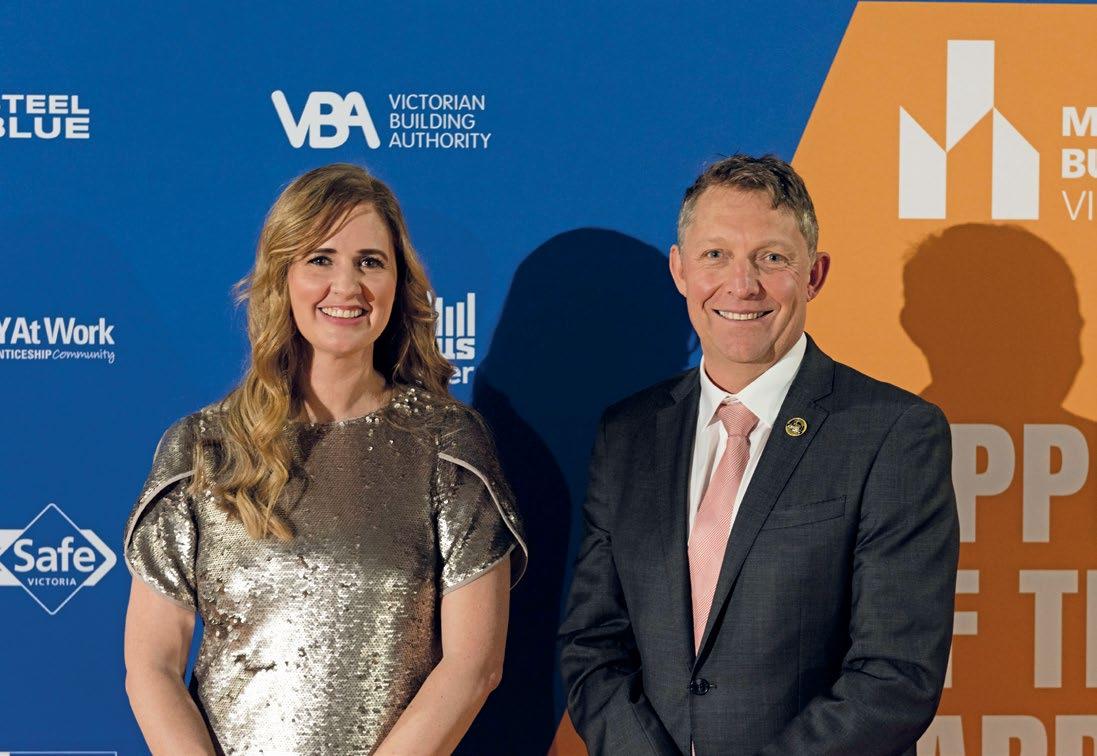
Dear members,
As we move further into 2025, it’s been a pleasure to reflect on the achievements of recent months and the momentum building within our industry, particularly when it comes to the next generation of trades and construction professionals.
First, I extend my congratulations to everyone who took part in the 2025 MBV State Apprentice of the Year Awards. It was a wonderful night, celebrating the dedication, growth and talent of apprentices across Victoria. I’d also like to acknowledge the winners from each of our Regional Apprentice of the Year Awards held earlier in the year. These apprentices embody the values of craftsmanship, integrity and innovation that define the Master Builders Victoria community.
It’s remarkable to think how many careers have begun with these awards. Apprentices recognised decades ago have gone on to become business owners, mentors, and leaders in our industry – some even returning to support the very same awards that once launched their own journeys.
It’s a powerful reminder of how investing in people creates a legacy far beyond the moment of recognition. Their success is a shared one. It’s a testament to the employers, supervisors and trainers who invest time and energy into guiding their development. Whether through formal training or on-the-job mentoring, you are helping build not just careers, but a stronger, more skilled and resilient industry.
As we look ahead, ensuring a steady pipeline of workers remains one of our most significant shared responsibilities. The need to attract and retain apprentices - and to support them to succeed - has never been more important. MBV remains intensely focused on creating opportunities for early career entrants and making the pathways into our industry more transparent, flexible, and inclusive. Through continued advocacy, education and collaboration, we can help young people find rewarding careers in building and construction, and ensure they are equipped with the skills and support to thrive.
To every member who has taken the time to employ, mentor or train someone starting out - thank you. You are making a meaningful contribution to the future of our industry.
Together, we have the power to shape a strong, skilled and sustainable industry and leave a legacy we can all be proud of.
Warm regards,
Geoff Purcell President, Master Builders Victoria


Melbourne’s Marvel Stadium was buzzing with pride and anticipation on Thursday 8 May as more than 620 guests gathered to celebrate the 2025 Master Builders Victoria (MBV) State Apprentice of the Year Awards. The annual event, a highlight on the building and construction industry calendar, honoured the achievements of Victoria’s most talented and dedicated apprentices.
Six outstanding metropolitan apprentices were formally recognised for their skills, hard work, and passion for their trade. They joined five category winners across regional Victoria who received their awards at events earlier in the year. Together, these top apprentices represented the best of the next generation of Victorian tradespeople. The evening culminated in the announcement of the prestigious 2025 State Apprentice of the Year Award winner, with 22-year-old Sebastian Blacket from Burwood taking home the honours.
Sebastian, a third-year Landscape Construction apprentice with Greener Visions Landscapes and student at Holmesglen Institute was also further recognised for his efforts in winning the State Apprentice of the Year –Craftsperson Award.
From backyard tinkerer to top-tier apprentice, Sebastian’s path into landscape construction was driven by an early love for construction and design. Unsure whether to pursue carpentry or landscaping, he initially completed a Certificate II pre-apprenticeship in both trades while finishing his VCE. Ultimately, his passion for creating outdoor spaces led him to landscape construction - a decision that’s now earned him statewide recognition.
“I’m really honoured to win these awards, and I want to say a huge congratulations to all the other winners!” said Sebastian.
Delighted with his win, Sebastian now wants to add landscape design to
his list of talents, and also become a registered builder.
MBV President Geoff Purcell said he was thrilled to see the quality and the passion of the next generation of the industry coming through.
“Sebastian is a standout winner for State Apprentice of the Year against a very strong field of contenders,” said Mr Purcell. “It’s great to see these really committed apprentices doing so well and looking forward to their future careers in our industry,” he said.
“My congratulations to all our winners and we hope we can encourage many more keen apprentices to join our industry which offers so many jobs and opportunities for skilled workers!”
MBV CEO Michaela Lihou highlighted and paid tribute to the critical role of employers, trainers, and families in supporting apprentice success. “Without their ongoing encouragement and support, we wouldn’t be seeing these great achievements being celebrated at the awards tonight,” she said.
I’m really honoured to win these awards, and I want to say a huge congratulations to all the other winners!
- Sebastian
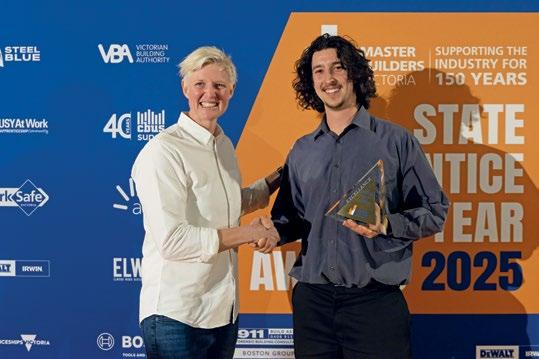
Last year’s State Apprentice of the Year, Perin
congratulating the 2025 winner Sebastian
This year, over 380 apprentices received Certificates of Excellence, with a total of 204 apprentices being nominated for the top awards.
Other State Award winners recognised on the night included:
• Sebastian Blacket, Burwood Apprentice of the Year – Craftsperson Award
• Alexandra Thwaites, Kennington Apprentice of the Year – Developing Leader Award
• Grayson Cooper, Officer Apprentice of the Year – Excellence in Trades Award
• Ryan Laxton, Aspendale Gardens Apprentice of the Year – Future Builder Award
• Tate Chisholm, Yarram Apprentice of the Year – Junior Trades Award
• Ali Jamshi Hazara, Narre Warren President’s Award
In addition to the apprentice honours, Noordenne Constructions was recognised with the Brian Fitzmaurice Memorial Award for its commitment to apprentice development. Meanwhile, Bendigo TAFE trainer Torin Coakley received the Master Builders Trainer Recognition Award.
This year also marked the introduction of two new special recognition awards, thanks to the generosity of MBV life member, Glenn Jones.





These awards aim to support apprentices with ambitions of starting their own businesses by helping them take the next steps toward becoming registered builders. The recipients were:
• Luke Wilson Regional Victoria Award
• Ryan Laxton Metropolitan Melbourne Award
The 2025 MBV State Apprentice of the Year Awards not only honoured the achievements of individuals but also showcased the strength and future promise of Victoria’s building and construction industry. With these apprentices leading the way, the future of the industry looks brighter than ever.



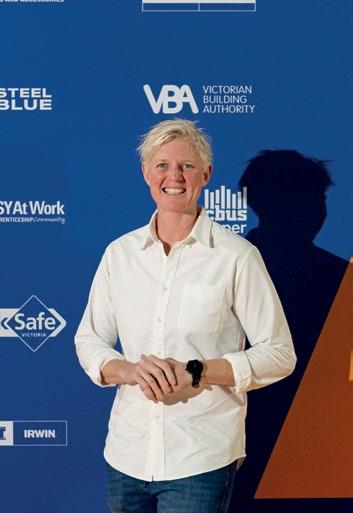
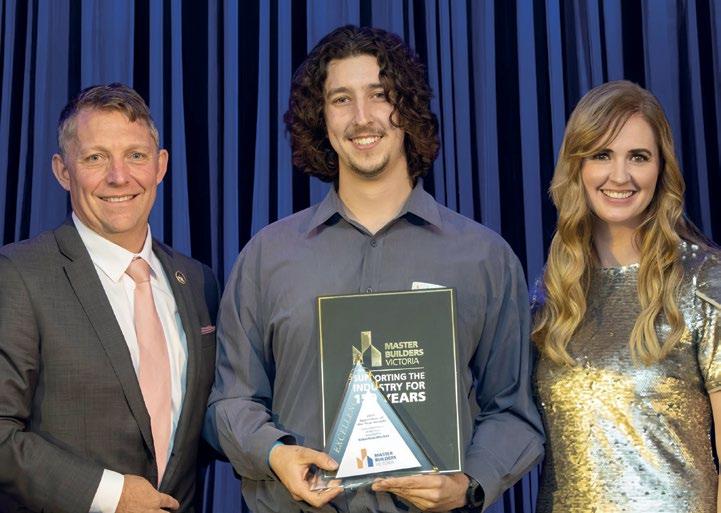
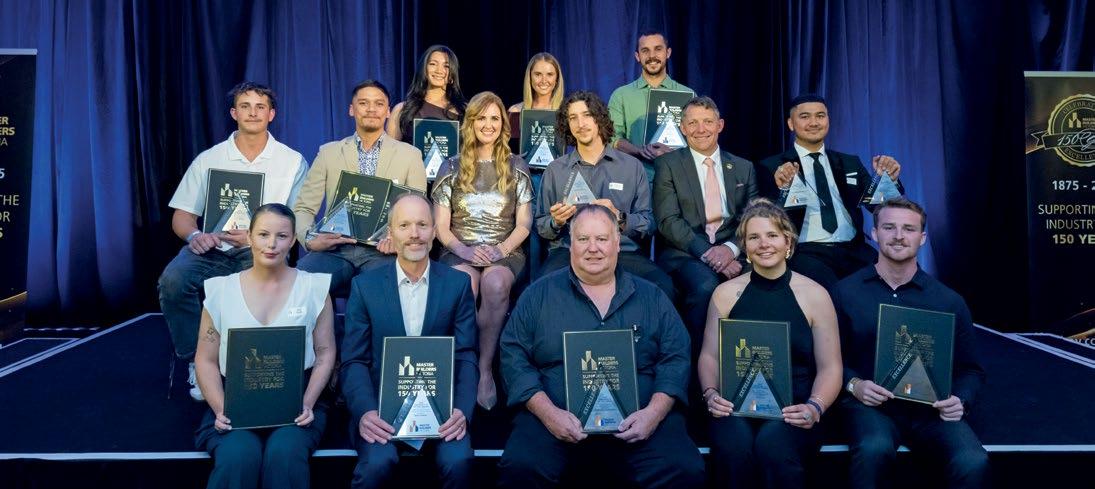
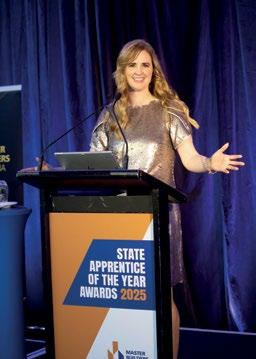
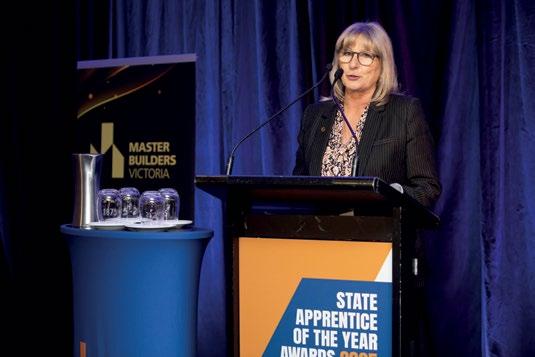
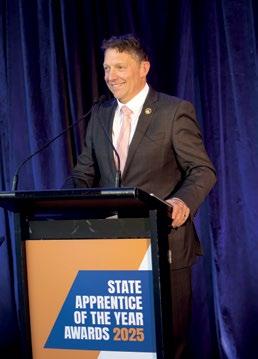
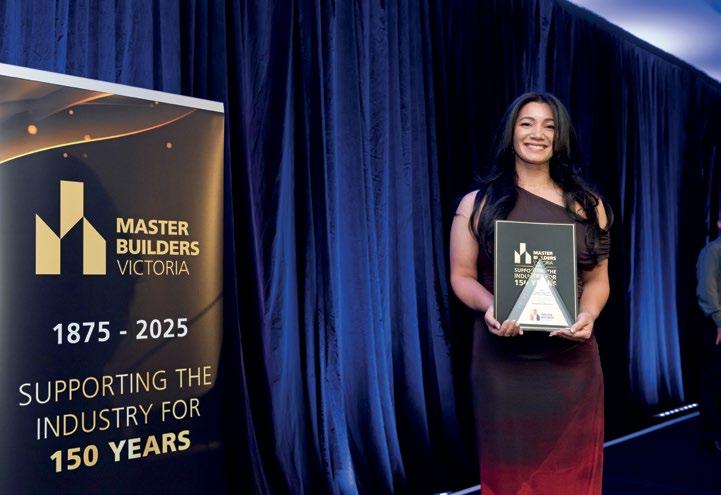
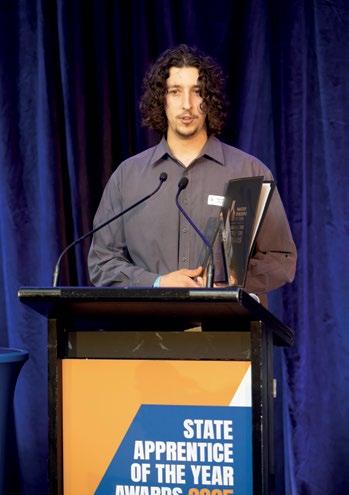


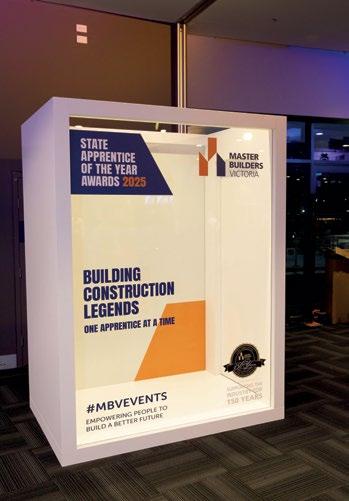
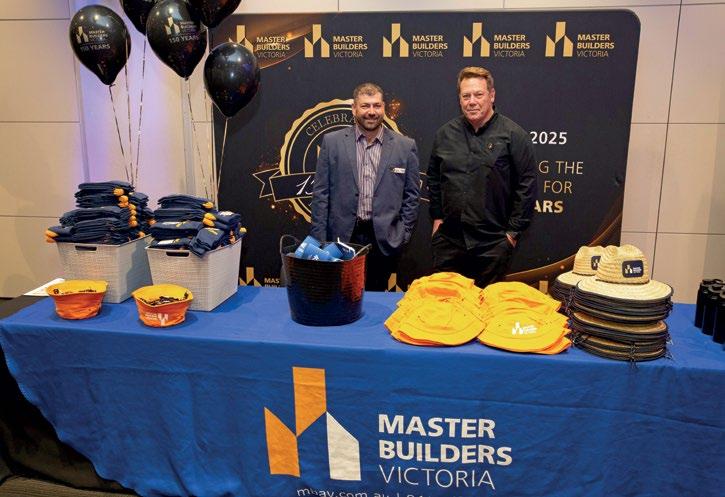
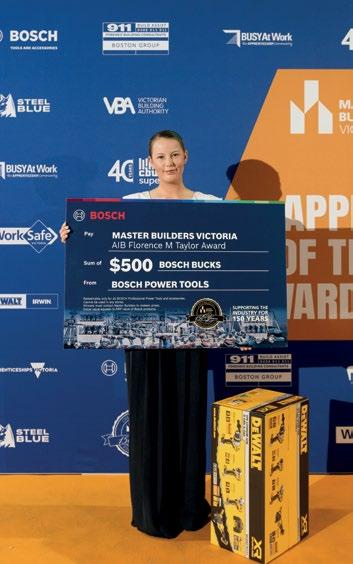
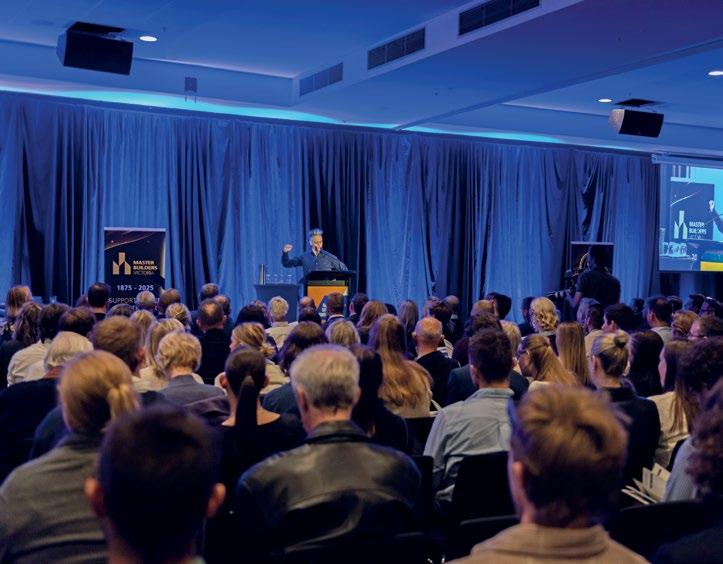

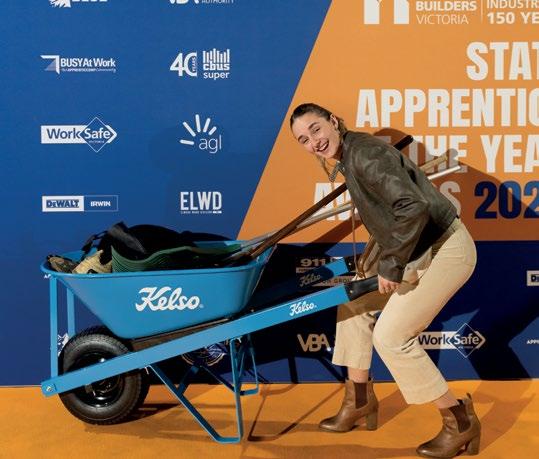
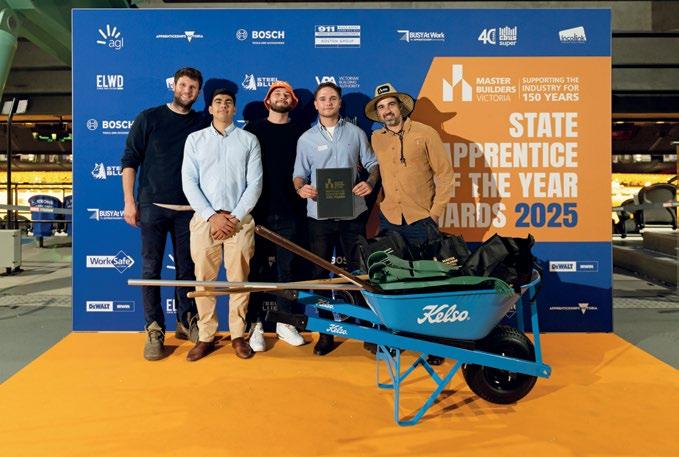
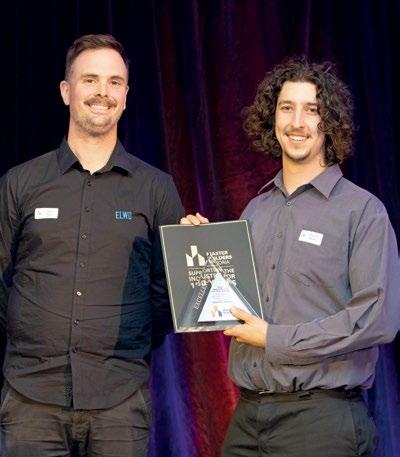


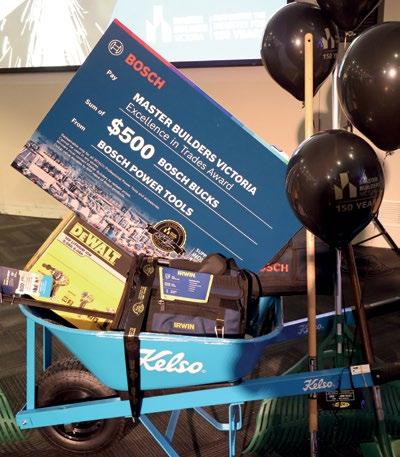
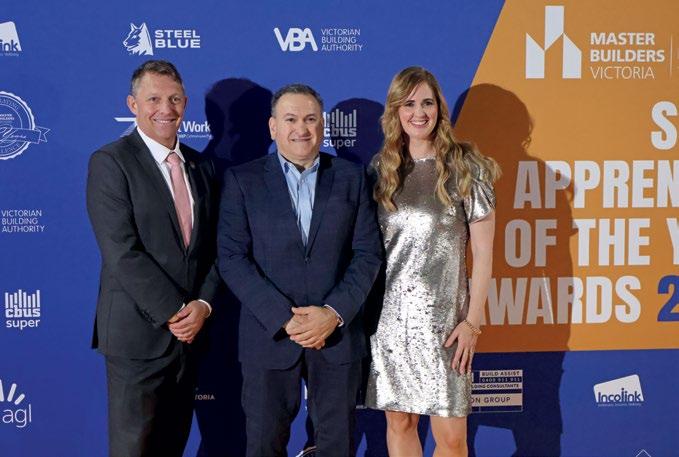

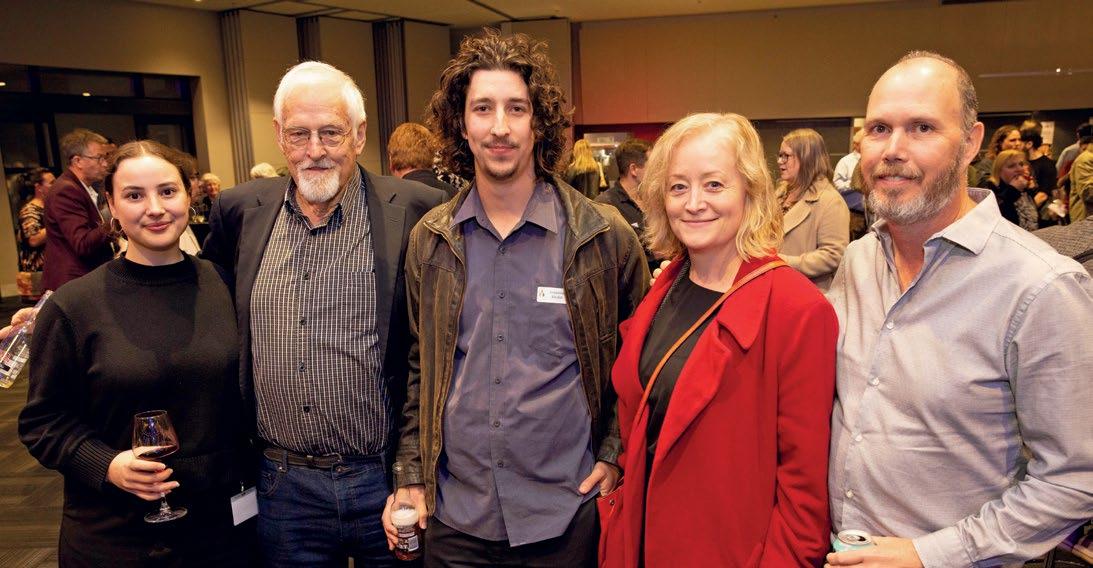

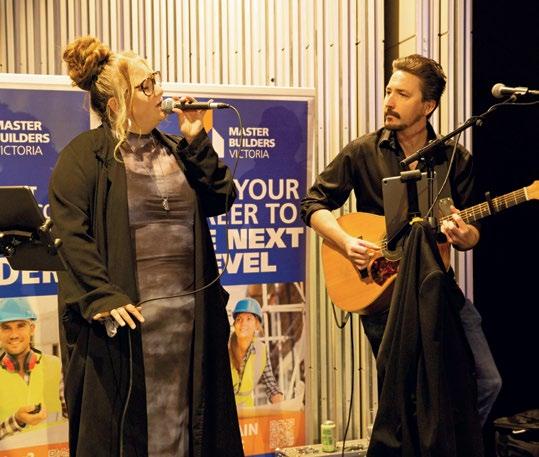




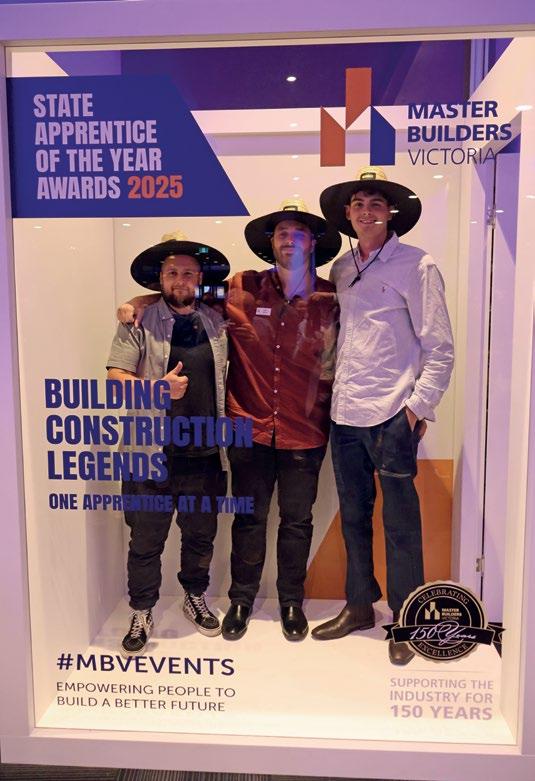
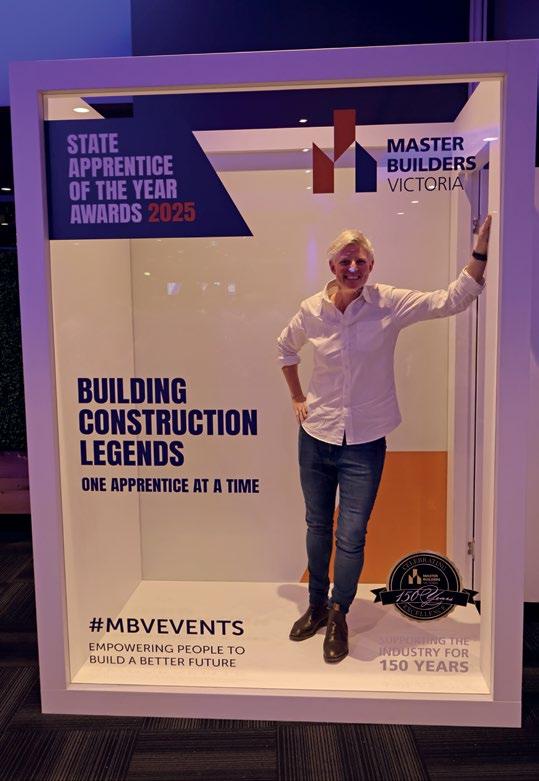
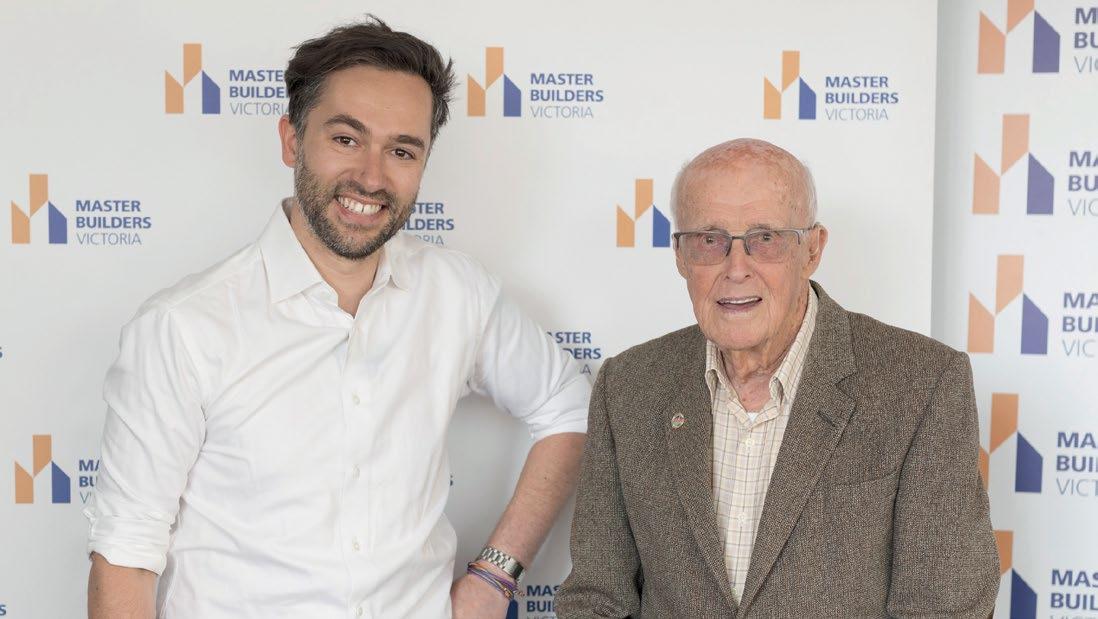
He walks into the studio with ease of muscle long trained - no cane, no helping hand. Just sure steps, a warm nod, and eyes that still appraise the room like the builder and businessman he is, steady and sharp. He adjusts the microphone with quiet precision, knowing instinctively where it belongs, how it works. Of course he does.
It’s Mort Mitchell. In front of us stands not just a centenarian, but a craftsman of time itself, a man who hasn’t simply watched a century unfold, but helped shape it, brick by brick.
For many Victorians, their first dream of a home began with Mort. He didn’t just build houses. He built belief in ownership, in innovation, in what a home could be.
Sitting across from him is MBV Executive Director of People and Member Services, Giovanni Abelardo, who leads the interview with admiration. One chapter of MBV in conversation with another.
For Giovanni, like so many of us in the industry, this moment is not just a conversation, it is a privilege. A rare chance to sit beside a living legend whose hands helped lay the foundation that we all build on today.
Fresh out of the Air Force in 1945, with no formal carpentry training and very little experience, Mort decided to build his first house. With the help of his father and uncle, he picked up the tools and began constructing what would become a cornerstone in a much larger story.
“We bought a block for £42 and 10 shillings, just four pegs in the ground. No water, no power, no drainage, nothing!” Mort recalled. “I didn't know much, but I learned as I went. We got the frame up, put the roof on. Two days of carrying tiles up a ladder by hand.”
That modest first home sparked something bigger. One house became two. Then came the company: M.A. Mitchell & Son, which would evolve into Spaceline Homes, and eventually become one of the largest volume home builders in Australia.
But it wasn’t just about volume. It was about vision.
In a move that would revolutionise residential construction, Mort pioneered a concept that didn’t yet exist in Australia at the time: the display home. “There weren’t any display centres then,” Mort said. “Maybe someone would open a house for inspection, but councils would usually shut it down. We took a risk. Built one in Glen Waverley. Opened it to the public. They had to call the police to manage the crowds.”
From that single home, Mort’s idea blossomed. Within a few years,
I didn't know much, but I learned as I went. We got the frame up, put the roof on. Two days of carrying tiles up a ladder by hand.
Spaceline Homes had created multiple display centres across Melbourne, forever changing how Australians selected and purchased homes. This approach gave buyers not just a blueprint, but a vision and a tangible experience of what their future could look like.
The innovation caught national attention. In one memorable instance, then Premier Henry Bolte, flew into a Spaceline display village by helicopter. Mort and his team had built what could only be described as the “Ramsey Street of real estate marketing”.
Mort’s innovations were not limited to home design. Throughout the decades, he championed advances in prefabricated construction, concrete slab foundations, and computer-based planning long before such things were commonplace. His foresight made construction more efficient, more scalable, and more accessible.
He brought the same forward-thinking energy to Master Builders Victoria, where he served in almost every role imaginable: President, Chief Judge, Mediator, Industrial Advocate, and ultimately, Life Member. His advocacy helped secure better industrial relations, fairer pay structures, and critical government support for the industry.
In fact, Mort played a key role in one of the most significant housing policy shifts in Australian history. Alongside federal colleagues, he successfully lobbied the Whitlam Government for a $150M stimulus, branded the “Heartstart” program, that helped revive a struggling housing sector.
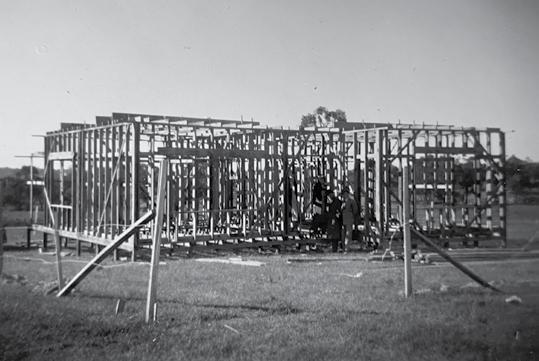


Among Mort’s proudest achievements is his leadership in creating Master Builders Insurance Services. After a previous insurer collapsed, Mort recognised the vulnerability this posed to builders. “We had to move fast,” he said. “I pushed for an MBA-backed insurance solution. It worked and today it serves builders across the country.”
Whether negotiating with unions, advocating in Canberra, or mentoring the next generation of builders, Mort has always believed in working with people, not against them. “I found that if you treat people with respect, you get cooperation,” he said.
A Legacy That Endures
Today, at 100 years old, Mort recently visited the very first home he built. It’s still standing. “Just like me,” he laughed.
Mort Mitchell’s legacy is measured not just in the homes he helped build, or the countless policies he helped shape, but in the culture of professionalism and purpose he infused into the building industry.
He is, quite simply, a master builder in every sense of the word.
From all of us at Master Builders Victoria—thank you, Mort. You didn’t just build homes. You built history.
Keen to see more? Watch the entire interview here:
ARTICLE AUTHOR
MBV Communications Specialist: Nadisha Wick



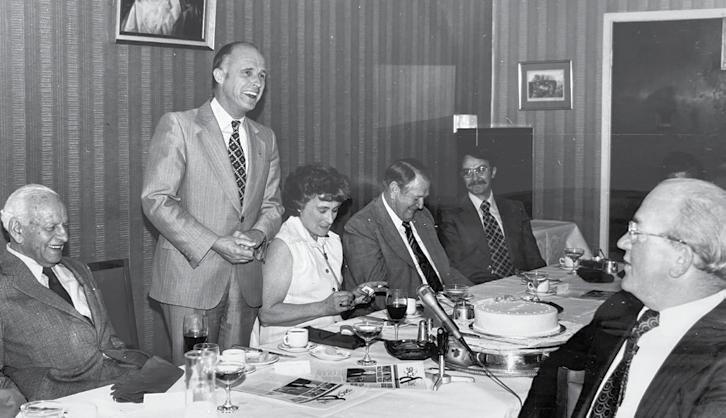
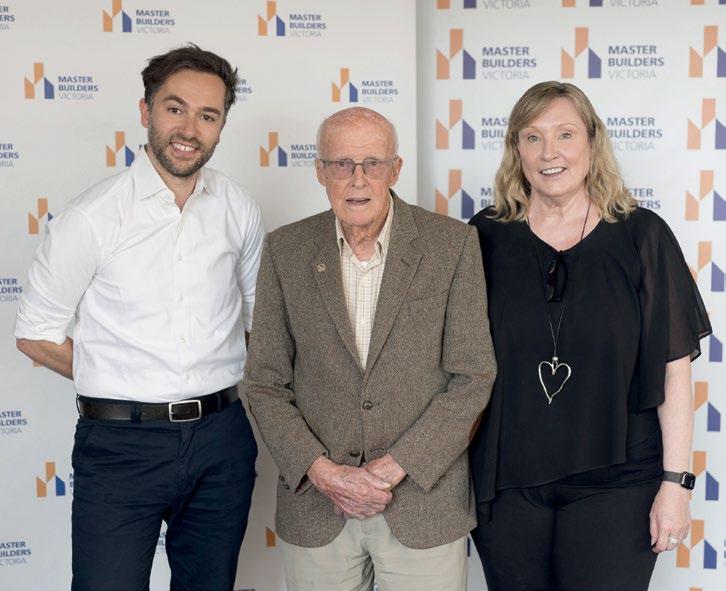
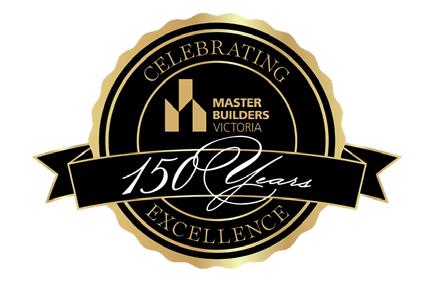

In the 2023-24 Federal Budget, the Government announced that from 1 July 2026, employers would be required to pay workers’ super at the same time they pay salary or wages.
Payday Super aims to create a fairer super system. While most employers do the right thing, unpaid super remains an issue that affects one in four Australian workers. In the 2021-2022 financial year, 2.8 million Australians missed out on super worth $5.1 billion.1
If it’s introduced as planned from 1 July 2026, Payday Super will help address unpaid super by:
• Helping ensure that super contributions are made on time
• Giving workers better visibility of when their super is paid and a clearer picture of their retirement savings.
Many employers currently pay their workers’ super monthly or quarterly.
The good news is that paying super on payday, means fewer liabilities building up over time, which may make managing cash flow easier. Plus, it lines up with payroll processes, reducing the administration of making separate super payments.
If the legislation passes, Payday Super is currently proposed to come into effect on 1 July 2026.
The Government released Payday Super draft legislation which proposes to implement design principles outlined in their September 2024 Payday super fact sheet (PDF).
Download the PDF fact sheet.
We’re here to help When more information is available, we'll share updates and practical guidance.
If you have any questions, contact us on 1300 361 784 8am to 8pm (AEST/AEDT) Monday to Friday or visit cbussuper.com.au
1 https://smcaustralia.com/app/ uploads/2024/08/Fixing-unpaid-superSMC-Report-August-2024.pdf - Super Member’s Council.
This information is about Cbus Super. It doesn’t account for your specific needs. Please consider your financial position, objectives and requirements before making financial decisions. Read the relevant Product Disclosure Statement (PDS) and Target Market Determination to decide if Cbus Super is right for you. Call 1300 361 784 or visit cbussuper.com.au.
United Super Pty Ltd ABN 46 006 261 623 AFSL 233792 as Trustee for the Construction and Building Unions Superannuation Fund ABN 75 493 363 262 (Cbus and/or Cbus Super)

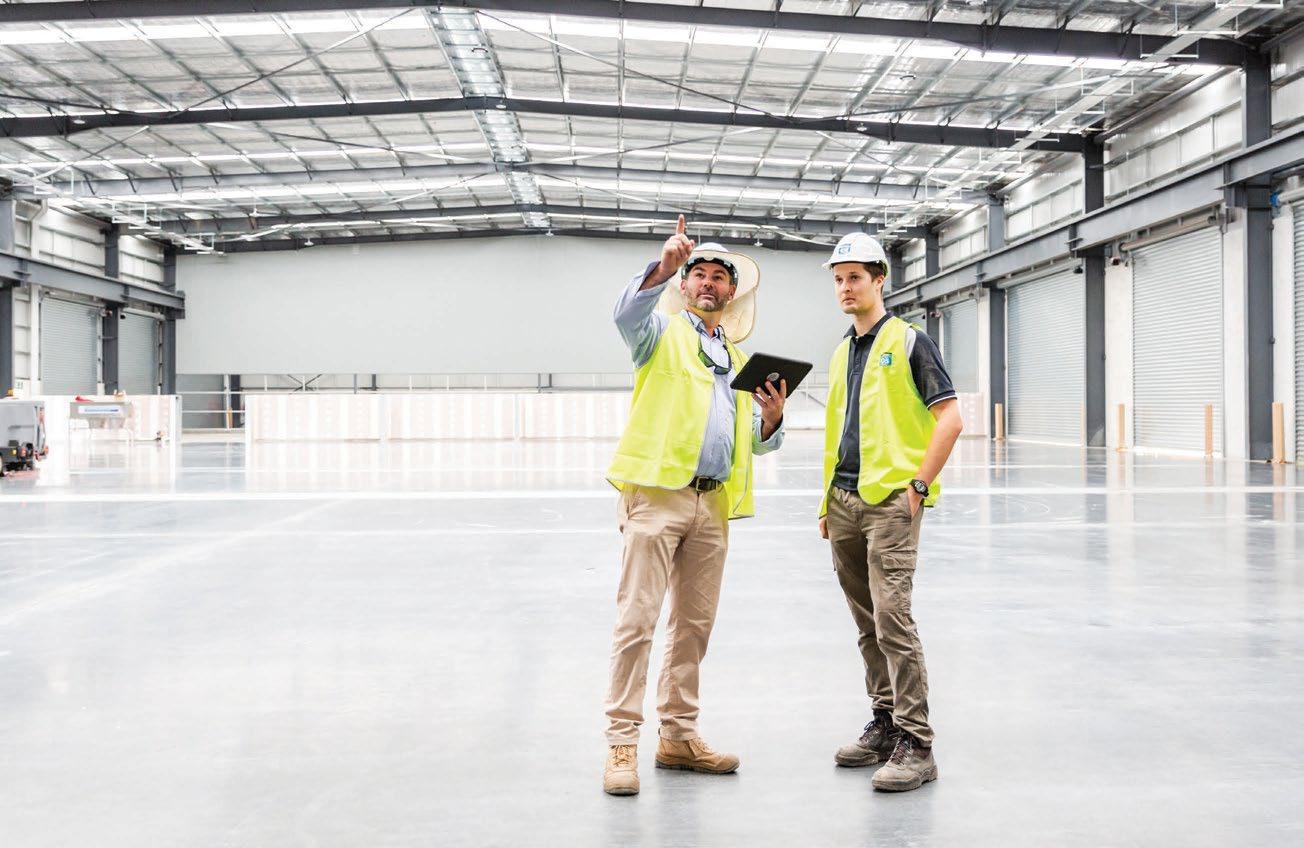


It has been a fast-paced and significant quarter for Victoria’s building and construction industry, with major state government announcements set to reshape the way builders operate, train the next generation of tradespeople, and deliver housing across the state. From the release of the 2025–26 Victorian State Budget to the passing of the Building Legislation Amendment (Buyer Protections) Bill 2025 and the introduction of the Domestic Building Contracts Amendment Bill 2025 into Parliament, Master Builders Victoria (MBV) has been at the forefront, ensuring members’ voices are heard and their interests represented.
MBV continues to work closely with government and stakeholders to shape these reforms—securing some important wins while remaining firmly committed to driving improvements where needed.
The Allan Government delivered its 2025–26 Budget with a strong focus on the state’s broader priorities: health, education, transport, and easing the cost of living. While not all of MBV’s recommendations in its Pre-Budget Submission were adopted,
the Budget did deliver some welcome news for Victoria’s builders and construction professionals.
Significantly, the Victorian Government has maintained its commitment to the TAFE and training sectors—a crucial pipeline for the future of Victoria’s construction workforce. The Budget includes:
• $50M to establish the Melbourne Polytechnic Future of Housing Construction TAFE Centre of Excellence.
• $22.8M to support apprentices, in line with the Apprenticeship Taskforce’s recommendations.
• A broader $459.3M investment into TAFE and training across multiple sectors.
• An additional $171.3M to help Victorians upskill and reskill into priority industries.
• $43.7M to boost completion rates by enhancing foundation skills via TAFEs and Learn Local providers.
“A future-ready workforce begins with investment in skills and training. MBV welcomes the Government’s focus on preparing tomorrow’s builders today,”
On housing delivery and affordability, the Budget offers limited direct measures but includes some important planning reforms such as:
• $24M to implement new planning controls in 50 designated activity centres.
• $12M to unlock additional greenfield land for housing development.
In the sustainability space, the government retained support for energy efficiency upgrades:
• $29.7M to help 27,000 homes install electric heat pumps and solar hot water systems.
• $12M to halve the average cost of ceiling insulation for households, reducing the typical expense from $3,000 to $1,500.
MBV also acknowledges funding towards economic growth initiatives, including:
• $3M for the Global Talent Attraction Fund.
• $4.9M to enhance the Business Victoria digital service.
• $1M to expand the business mentoring program.
Read MBV’s media release regarding the 2025-26 State Budget here
However, notably absent was any specific allocation to support the Victorian Building Authority’s transition to the new Building and Plumbing Commission (BPC)—a key structural reform raising questions about implementation readiness.
Alongside the Budget announcements, Parliament passed the Building Legislation Amendment (Buyer Protections) Bill 2025, introducing major compliance changes for builders and developers. While the Bill is positioned as a consumer protection measure, MBV remains deeply concerned about its potential and the unintended consequences for builders.
Key reforms include:
• Establishment of the Building and Plumbing Commission (BPC), replacing the Victorian Building Authority.
• Introduction of Rectification Orders (ROs) enforceable for up-to 10 years post-completion.
• A move to a ‘First Resort’ Insurance Scheme, allowing consumers to claim compensation without proving insolvency or disappearance of the builder—due to commence by July 2026.
• New financial solvency requirements tied to builder registration.
• Mandatory developer bonds (2% of build cost) for Class 2 apartment developments above three storeys.
While the government clarified that ROs can target all responsible parties including unregistered builders, subcontractors and ownerbuilders, MBV remains concerned that the primary burden will fall disproportionately on registered, insured builders.
Further, the lack of clarity in the Bill regarding definitions of ‘defect’ and ‘serious defect’ may lead to inconsistent enforcement. MBV advocated for these to be properly prescribed in regulations following further industry consultation.
Although the Bill passed without amendment, MBV welcomed public commitments by the Minister for Housing and Building to address some industry concerns in the forthcoming regulations. These include phased rectification processes and broad accountability for defects commitments that MBV insists must be embedded in law to provide certainty.
Amendment Bill 2025 was also introduced into parliament, marking a significant step forward in modernising the legislative framework for domestic building in Victoria.
This progress follows MBV’s strong and consistent advocacy on behalf of members to ensure the Act better reflects the realities of today’s building and construction industry. Since November 2023, MBV has been actively engaging with the Victorian Government to influence these important reforms, and we are pleased to see several of our key priorities reflected in this Bill.
In a major win, the Bill now recognises the preparation of plans and specifications, and bills of quantity as preliminary works by removing them from the scope of Major Domestic Building Contracts.
We advocated for reform to cost escalation clauses in Major Domestic Building Contracts. The Bill now includes reforms to apply cost escalation clauses to contracts over $1M. We are continuing to advocate for cost escalation clauses to apply to contracts less than $1M, which represents the vast majority of domestic building contracts.
For the first time, the Bill introduces three tailored contract types to accommodate projects involving MMC. This recognises the changing nature of how homes are being built and provides greater clarity for builders working with innovative construction techniques.
We also welcome the decision to transfer prescribed payment stages from the Act to the regulations. This will allow for greater flexibility and responsiveness to evolving building practices. MBV looks forward to working closely with government to shape these regulations, to ensure they are practical and fair for our industry.
The practical impact of these changes will depend heavily on the details set out in future regulations and industry engagement during the Regulatory Impact Statement (RIS) process expected later this year. MBV will lead this engagement to ensure member concerns shape the final regulatory environment.
The building regulations are not the only change members should be aware of. It is expected that an update to the Domestic Building Contract Acts will be announced shortly. We will continue to update our members on the development within this space.
OWNER OCCUPIERS
Buildings Still Under Construction as of Dec 2024
Building Work Commencements during year to Dec Quarter 2024
Building Work Completions during year to Dec Quarter 2024
22,901 Multi-unit
32,957 Detached

1,000 2,000 3,000 4,000 5,000 6,000 7,000
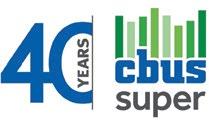
Friday 14 November 2025 | 6:30pm - 11:59pm
Available to MBV members only MC: News Presenter Nine News Melbourne
Scan the QR code to book

Peter Hitchener OAM





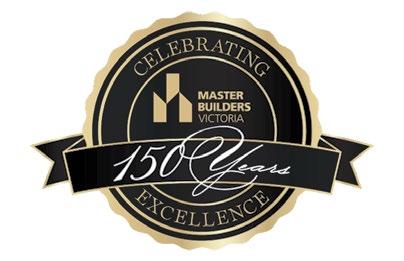
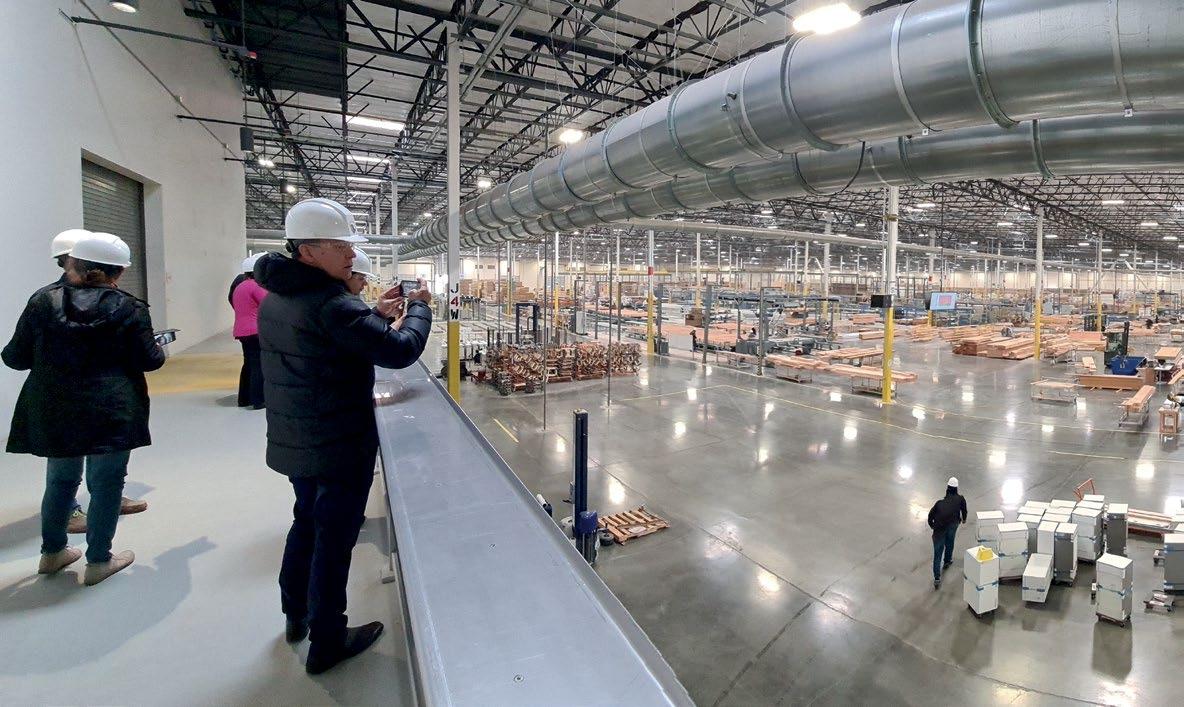

Master Builders Victoria continues to support and work with the Building 4.0 Cooperative Research Centre (CRC) on a range of projects designed to improve the capacity and efficiency of the building and construction industry. Currently, projects include investigations into the future of work, insolvencies in the industry, smart contracts and remote building inspections.
A comprehensive report from a 12-month project into Regulatory Reform for Industrialised Construction has just been released by the CRC, marking a pivotal moment for the sector. With both Federal and State Governments acknowledging the need to quickly tackle Australia’s housing supply crisis, the spotlight is now on off-site construction as a key solution. Off-site construction, also referred to as prefabricated construction, modern methods of construction (MMC) or modular construction, promises to improve efficiency, reduce costs, and enhance quality.
The current regulatory frameworks in Australia have been structured around conventional onsite construction, which limits the efficiencies possible with MMC. This project examined the challenges associated with the current regulations, and identified reforms that will improve compliance, streamline approvals, and enhance industry confidence in MMC.
• Compliance Pathways: Existing compliance pathways, particularly "Deemedto-Satisfy" (DtS) provisions in the National Construction Code (NCC), hinder off-site construction processes, leading to reliance on complex and costly performance solutions.
• Lack of Standardisation: Australia lacks a unified classification system for prefabricated components, resulting in inconsistencies across states. This complicates the approval process as recognised prefabricated components approved in one state may not be installed in another.
• Certification Gaps: Existing certification schemes, such as CodeMark and WaterMark, focus on individual products rather than entire modular assemblies, leading to fragmented compliance pathways.
• Inspection and Compliance Issues: The role of building surveyors and certifiers in off-site compliance lacks clarity. Off-site construction often results in redundant inspections, either requiring multiple approvals for the same components or hindering manufacturing efficiency and requiring on-site inspections.
• Lack of Futureproofing: The current regulatory framework does not adequately account for emerging technologies and evolving construction practices, potentially stifling innovation in the sector.
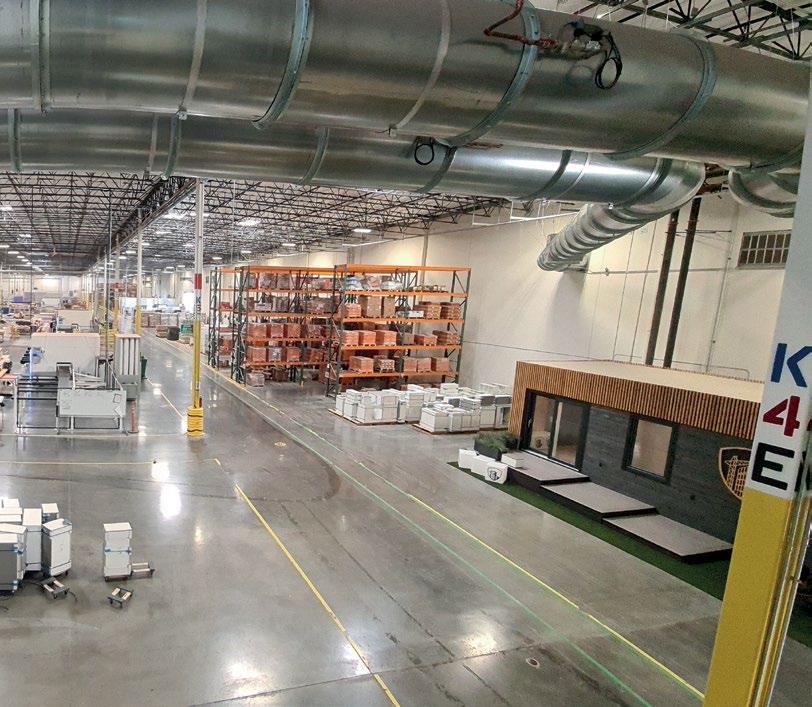
Several regulatory reforms were proposed by the study in an effort to streamline compliance, foster innovation and enhance efficiency of MMC.
• Development of a Unified Classification System: Establish a standardised national framework to classify prefabricated components, ensuring consistency in regulatory interpretation and approval processes.
• Expansion of Certification Schemes: Modify CodeMark and WaterMark to certify entire modular assemblies rather than individual products, drawing inspiration from international best practices such as New Zealand’s BuiltReady scheme.
• Harmonisation of State Regulations: Implement a nationally recognised system for prefabrication approvals, reducing the need for state-by-state reevaluations of prefabricated components.
• Revised Inspection Protocols: Introduce a risk-based approach to inspections, where certified off-site manufacturers undergo third-party audits, reducing the need for repetitive on-site inspections. Facilitate digital compliance mechanisms, such as real-time monitoring and traceability frameworks, to improve oversight without delaying production.
• Fire Safety and Quality Assurance Enhancements: Implement regulatory provisions specifically addressing fire safety risks associated with modular construction, particularly at interface points where prefabricated and in-situ elements connect.
• Legislative and Policy Adjustments: Amend key regulatory documents, including the National Construction Code (NCC), to explicitly recognise off-site construction as a building method with distinct compliance pathways. This can include integrating off-site-specific DtS provisions.
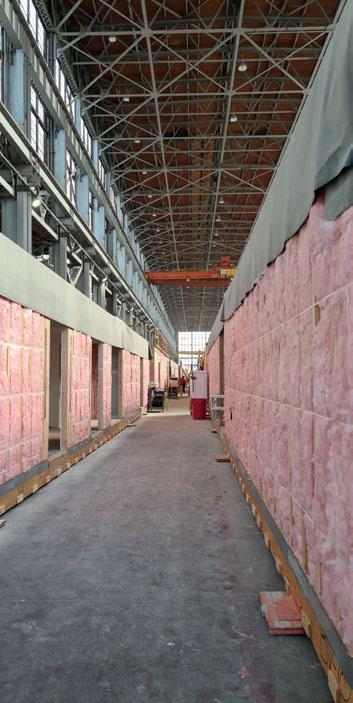
Australia's current regulatory framework is structured around traditional forms of on-site construction and is not well-suited to support the growth of industrialised construction. Without reform, compliance inefficiencies will continue to hinder the adoption of prefabrication and modular building techniques by diminishing the efficiencies of a streamlined process. The study recommends a coordinated national approach to regulatory reform, focusing on streamlined certification, harmonised state regulations, and modernised compliance pathways. These reforms allow the maximum benefits associated with MMC to be realised, and support cost-effective, high-quality, and efficient building delivery in Australia.
View a full copy of the report here
ARTICLE AUTHOR
MBV
Senior Advisor, Future Built
Environment:
Dr. Philip Alviano



For more than 150 years, Master Builders Victoria (MBV) has supported builders—advocating for industry standards, delivering accredited training, and helping its 6,200-plus members navigate the challenges of running building and construction businesses. Like many organisations that have evolved steadily over time, MBV found itself running on a patchwork of systems that were no longer fit for purpose.
As the membership base grew and services expanded, some areas began to show signs of wear. Different teams were using multiple platforms to manage finance, inventory, payroll, and customer relationships. Reporting the numbers was a laborious process involving Excel spreadsheets and manual data reconciliation. Staff were forced to navigate outdated systems that did not integrate, and critical insights were often buried beneath layers of tedious processes.
To address this complexity, MBV considered various solutions before implementing NetSuite ERP, a cloud-based platform. The change meant rethinking long-established processes, but it also opened the door to new possibilities and productivity improvements. NetSuite provided the
organisation with real-time financial visibility, automation of core accounting tasks, compliance and audit readiness, streamlined financial close process, scalability and flexibility, and integration with other business functions.
The impact was immediate. Financial reporting that once took days is now completed in half the time. Team members can access the same live data, allowing departments to work together more effectively and respond faster to member needs.
Beyond finance, NetSuite has also helped unify customer records, streamline inventory management, and automate previously manual tasks. As a result, MBV’s teams can focus more on delivering value to their members and less on backend admin. The singleplatform approach has also improved governance and provided clearer visibility across operations - crucial for an organisation balancing training, events, services, and strategic advocacy
In the building and construction industry, having a unified system is crucial to managing complex projects, finances, and team coordination. NetSuite ERP is the perfect solution, offering real-time data, centralised financials, and integrated project management. With features like automated workflows, streamlined inventory management, and easy reporting, businesses can reduce manual tasks, improve collaboration, and make smarter decisions faster. NetSuite helps you stay on top of budgets, compliance, and project timelines, giving you a competitive edge and setting the foundation for long-term, sustainable growth in the construction industry.
or email tania.large@oracle.com to access exclusive MBV member pricing and learn how NetSuite powers businesses in the construction industry.


Members can post their vacancies on our Jobs Board
Scan the QR code to share you vacancy

Apprenticeship vacancies
Apply directly to employers
Opportunities across Victoria
MBV Jobs Board is designed to connect those looking for a career opportunity in the building and construction industr y with Master Builders members.
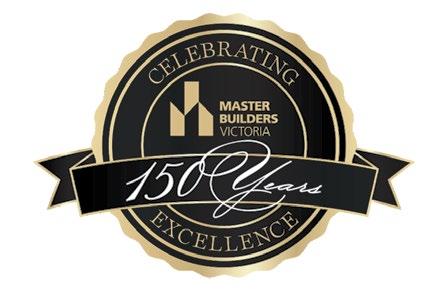
Applications for industry-led partnership projects to the Australian Government’s Building Women’s Careers Program were submitted in late 2024 and awarded in March this year.
Master Builders Victoria (MBV) have partnered on two of the successful applications and are looking forward to contributing to positive structural and cultural change that supports more women into our industry.
These projects are the Give Her a Chance project, with lead applicant Master Builders Australia, and the Women in Construction project led by Incolink.
Master Builders Australia’s Give Her a Chance project is based on the idea that to drive structural and cultural change to increase women’s skilled participation in construction, you must tackle the causes of bias head-on.
Give Her a Chance is a multi-faceted program that seeks to reach, educate and support the key demographics that influence a woman’s success in building and construction: employers and peer-to-peer (male-to-male and male-to-female).

This program will be delivered across Australia through campaigns, mentorship programs, networking events, best practice resources, and partnerships. The program will leverage the connections of all project partners and established networks to reach all areas of the industry, and provide crucial resources and support for employers and the workforce.
Partners on the project include nine Master Builder State and Territory Associations, Brickworks Building Products Pty Ltd, the Australian Worker’s Union, Civil Contractors Federation and Bunnings Group Ltd.


Incolink’s Women in Construction project will support women to train, obtain and retain skilled roles by eliminating structural and cultural barriers to gender equity.
The program will comprise training and employment for women in skilled construction roles, wraparound services to support success, and worksite interventions to address cultural barriers.
It builds on the success of the Victorian Government’s Building Equality program and is designed to scale and continue beyond the funded period. It is overseen by a governance body that
brings together key industry participants who are committed to harnessing the program’s momentum across the building and construction sector.
It has been set up as a national partnership of construction employers, workers, Registered Training Organisations (RTOs), Group Training Organisations (GTOs), Non-Government Organisations (NGOs) and industry bodies across Victoria, New South Wales, Tasmania and South Australia.
For more information visit the Australian Government Department of Employment and Work Relation's Website
ARTICLE AUTHOR
MBV Executive Director, Collaboration & Innovation: Dr Corrie Williams Department of Employment and Workplace Relations

The MBV Site Management Training Program is meticulously designed to prepare aspiring site managers for success in the dynamic building and construction industry. This two-year pathway equips participants with critical skills, knowledge, and practical experience, utilising a blend of simulation and classroom delivery. Below is an overview of the courses undertaken during both program years.
The diverse mix of simulation and classroom training equips site managers with the confidence they need to thrive in a challenging yet rewarding industry.
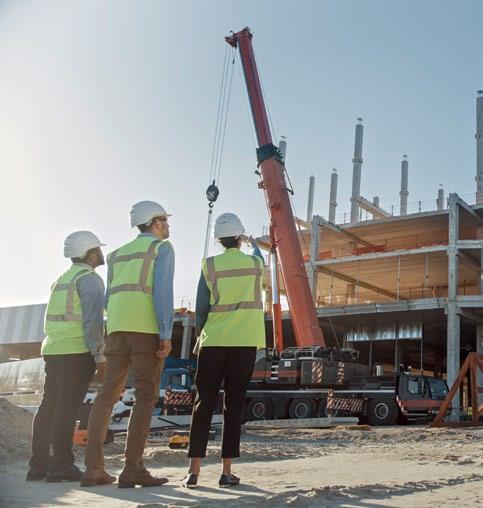
In the program's first year, participants embark on foundational courses to develop essential skills in leadership, communication, time management, industrial relations, and occupational health and safety (OHS).
Leadership Essentials (Simulation, 1 Day)
Participants explore the core concepts of effective leadership, enhancing their ability to inspire and manage teams.
Managing Priorities (Time Management) (Classroom, 1 Day)
This course focuses on effective prioritisation techniques, allowing site managers to enhance productivity and meet project deadlines.
with Difficult Situations & People (Simulation, 1 Day)
Participants learn strategies for resolving conflicts and managing difficult conversations, which is vital for effective site management.
of
(Simulation, 1 Day)
This course teaches the legal aspects of site access and compliance, equipping managers with the knowledge to navigate complex industrial relations.
(Classroom, 0.5 Days)
Safety is paramount; this course provides essential knowledge on identifying and managing asbestos risks on site.
Microsoft Project for the Construction Industry (Module 1 - Beginner) (Classroom, 0.5 Days)
An introduction to project management software, this course lays the groundwork for effectively planning and scheduling construction projects.
OHS Refresher (Classroom, 1 Day)
Ongoing awareness of occupational health and safety standards is crucial, and this refresher course reinforces key safety practices.
Total Duration of Year One: 6 Days

The second year builds on the foundational knowledge from Year One, and delves deeper into advanced management concepts and project management training. This year enhances leadership capabilities while focusing heavily on structured project management methodologies.
High Performance Site Management (Simulation, 2 Days)
Participants learn to cultivate high-performing teams, focusing on on-site strategies that drive productivity and morale.
Microsoft Project for the Construction Industry (Module 2 - Intermediate) (Classroom, 0.5 Days)
This course builds on the skills learned in Module 1, advancing participants' abilities in project scheduling and resource management.
OHS Refresher (Classroom, 1 Day)
This course reinforces safety standards and ensures participants remain updated on the latest health and safety practices.
Leading Psychologically Safe Teams (Simulation, 1 Day)
This course emphasizes the importance of mental health and well-being in highpressure environments, affirming the site manager's role in fostering a supportive team culture.
Managing Onsite Industrial Relations (Simulation, 2 Days)
A detailed examination of managing relationships with various stakeholders on-site, including contractors, clients, and workers.
Total Duration of Year Two: 6.5 Days
Over the course of this twoyear pathway, participants gain a comprehensive education in construction site management, merging essential leadership, communication, industrial relations, and project management skills.
This program is crucial for those aspiring to oversee large construction projects and ensure they are completed efficiently, safely, and to the highest standards. The diverse mix of simulation and classroom training equips site managers with the confidence they need to thrive in a challenging yet rewarding industry.
Scan to learn more about this program or start enrolment.

To work in the building and construction industry in Australia, you must hold a current Construction Induction Training Card – also referred to as a CI or White card. This includes working in the domestic, commercial, industrial and maintenance space, as well as high-rise and civil construction.
Construction Induction Training cards (CI card) are provided upon completion of an approved Construction Induction Training (CIT) course.
The course is designed to enlighten participants to the hazards of working within the building and construction industry, teaching them awareness, basic risk management, hazard identification and emergencies, just to name a few. This course is usually completed in a day, over a 6-to-8-hour period.
Once you have completed the course, the CI/White Card will last for the entirety of your working career, provided you are continually working within the construction industry. Red cards issued prior to 1 July 2008 remain valid, and do not need to be transferred to construction induction cards.
Anyone who carries out construction work in Victoria needs to hold a construction induction card. This includes a wide range of roles, from site managers and supervisors to labourers and tradespeople, as well as those who routinely enter construction zones. Delivery drivers and cleaners who access construction sites without supervision may also require a White Card.
This includes young workers, students coming to site, work experience, and transient or temporary workers completing works for you over a short period. All workers coming to site to work are required to hold a CI card.
We often receive questions from PCs about what they should do when their client or other industry professionals come to site. Depending on the terms outlined in your signed contract with the client, it is recommended that you have a system in place to coordinate site visits.
Any site visits should be conducted with a PC company representative present to ensure compliance with safety and access protocols. It is not
necessary for the client to obtain a CI card for the works you are completing. It is important to note that clients or visitors must not walk around the site unsupervised.
Construction are a dynamic environment, with conditions constantly changing. Anyone who does not hold a valid CI card must be always be accompanied by a representative of the PC, or a suitably qualified company representative who holds a CI card. This supervision is to ensure that they are not exposed to hazards while visiting your site.
Each state in Australia has their own CI cards. It is not unusual to find workers in Victoria holding CI cards that have been issued from other states. Construction Induction cards from any jurisdiction are mutually recognised in across Australia. Further to this, an employer must not knowingly refuse to accept a current construction induction card, including those issued interstate.
It is very important that you carry your CI card with you. It is a requirement that the card be sighted or even
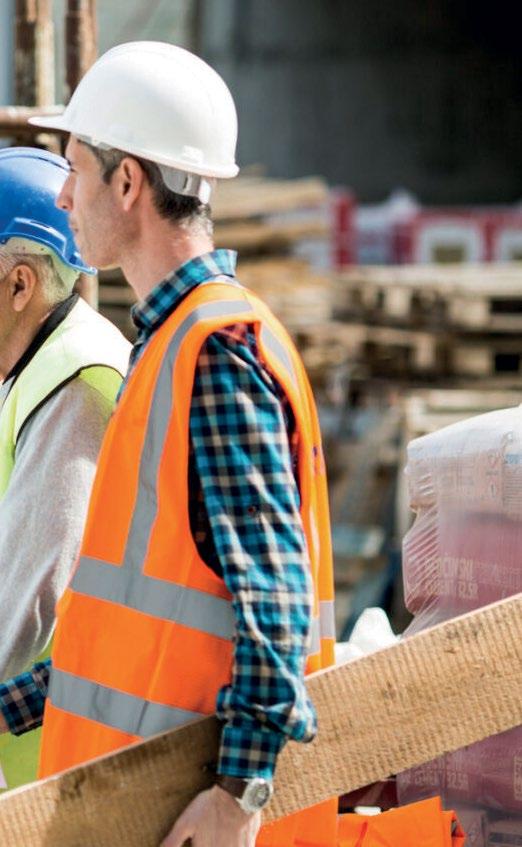
recorded by the PC when contractors arrive to commence work for the first time on-site.
What happens if I get caught working on a construction site without a CI Card?
WorkSafe may issue penalties if you are found to be working on-site without a valid CI card. Additionally, WorkSafe may also penalise the PC for not checking if the worker holds a CI card prior to commencing work on-site. WorkSafe currently have programs running including their ‘Priority Harms Campaign’, where inspectors drop into sites to review safety protocols such as falls from height, civil works, Silica dust issues, and demolition.
These visits are random, and can occur at any time. It is important the workers on your site are properly equipped and trained.
Where can we complete CI training?
Master Builders Victoria (MBV) is a Registered Training Organisation (RTO) that provide CIT training courses to both the public and our members.
Upon successful completion of all the requirements of this course, including assessment and attendance, participants will be issued with a Statement of Attainment by Master Builders Association of Victoria (RTO no 3935).
MBV then notifies WorkSafe Victoria who will issue the standard CI Card/White Card.
ARTICLE
AUTHOR
MBV OHS Advisor: Rod Armstrong Scan here for more information. Visit our website to complete your CIT course today!

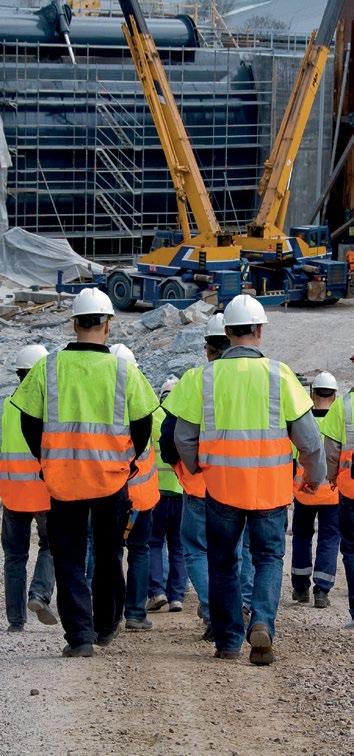
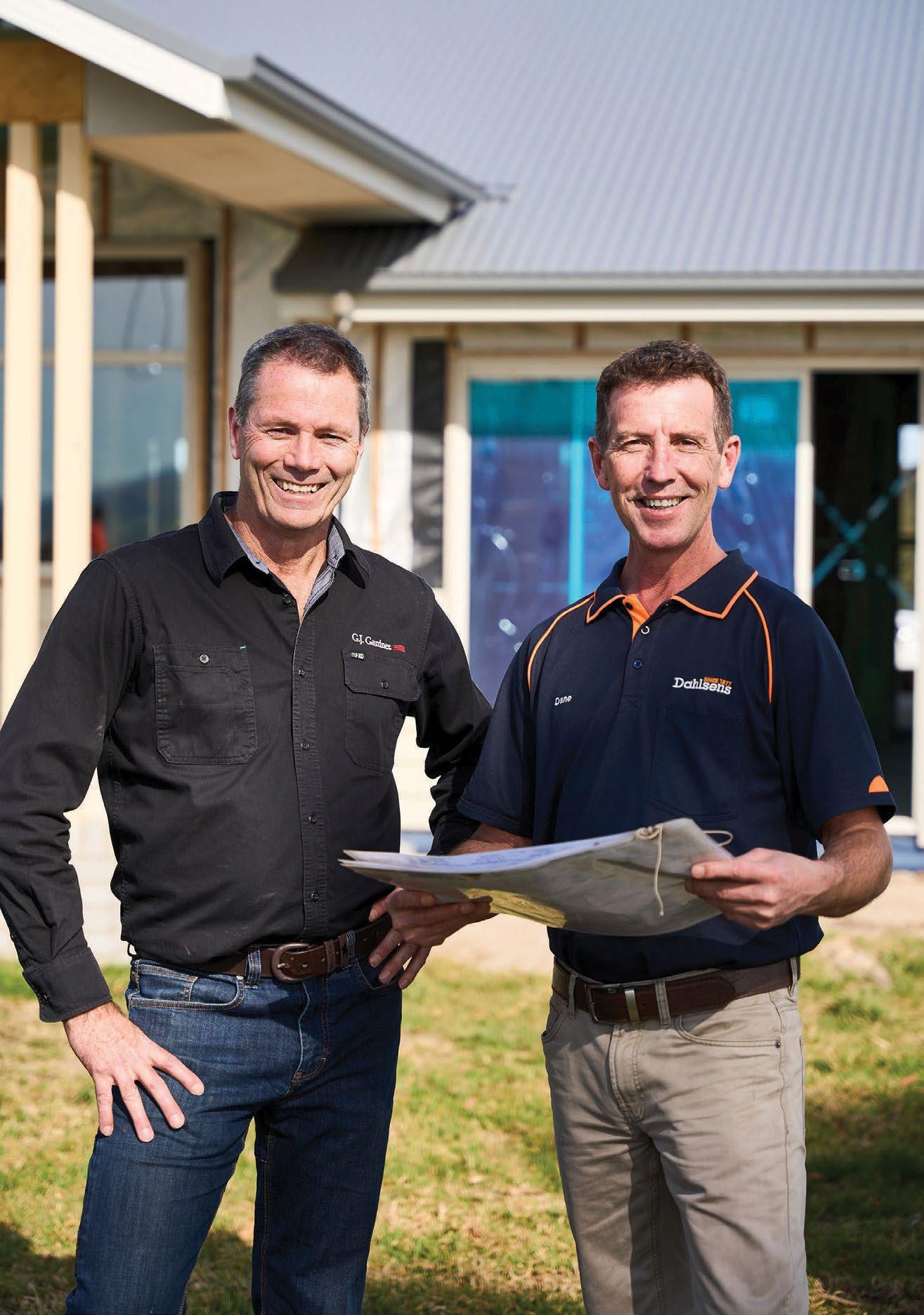




To support environmental sustainability and expand our reach, we are going digital! Our MBV Magazine will be primarily available in digital format for easier access and a greener future.
If you would still prefer to receive a physical copy, please register a request via the QR code below:

Progress payments are a crucial aspect of any domestic building contract. They provide clear and predictable payments to the builder at each stage and give owners confidence that they are paying for completed work. However, improper structuring or failure to comply with legislation, particularly the Domestic Building Contracts Act 1995 (Vic) (“DBCA”) and the Domestic Building Contracts Regulations 2017 (Vic) (“DBCR”) can lead to serious consequences.
Progress payments allow builders to receive payments in instalments as the project progresses. Section 40 of the DBCA defines standard stages of construction, such as the base, frame, lock-up, and fixing stages, and specifies the percentage of the contract price that can be claimed at each stage.
Importantly, builders are prohibited from requesting payment for work that has not yet been completed. Noncompliance can result in penalties of up to 50 penalty units which currently amounts to approximately $9,879.

Method A utilises the default stages and percentages outlined in Section 40 of the DBCA. Each stage must be fully completed before a progress payment claim can be issued. This method provides clarity and predictability, aligning with most standard domestic building contracts.
Builders should opt for Method A when a straightforward, low-risk progress payment structure is needed or when project funding is tied to bank approvals that require standard construction milestones. Under Method A, builders must wait until each prescribed stage is fully completed before issuing a progress payment claim, and claims must adhere to the allowable percentages established in Section 40.

Method B allows builders greater flexibility to establish alternative payment stages that better reflect the actual work completed on the project. This approach is particularly suitable for projects involving non-traditional construction methods or when a more detailed breakdown of works and payments is required. Renovations and extensions are common examples where this method is often used, as they require tailored progress stages to accommodate their variable scope of work.
However, Method B involves additional responsibilities. Each stage must be clearly defined and describe a distinct and identifiable component of work. For instance, a description might be "installation of kitchen cabinetry and appliances" rather than vague terms like "kitchen payment".
The payment percentages allocated to each stage must correspond to the amount of work completed at that time. Builders cannot, for instance, assign 50% of the contract price to work that represents only 10% of the project.
If Method B is used, the owner must sign an acknowledgment (Form 1) before signing the contract, and both parties must also sign Form 2 confirming their acceptance of the customised stages. These signatures must indicate consent and cannot simply be initialled without explicit agreement.
Even with Method B, builders must ensure that the work associated with a stage is genuinely completed before issuing a payment claim. The legislation does not permit invoicing based solely on the passage of time. Importantly, the description of each stage should be clear and specific enough that even an owner with no building experience can understand what is included, compare it to the completed works and make a reasonable assessment of whether the stage has been finished.

Regardless of whether Method A or Method B is used, builders should promptly issue payment claims upon completion of each stage. Most domestic building contracts require that payments be made within seven days or another agreed-upon timeframe after an invoice is issued.
Builders need to ensure that their contracts specify clear payment deadlines and actively manage compliance with these timeframes. Issuing invoices and promptly following up on late payments is essential.
If the owner has secured financing for construction, their lender may closely monitor and control payments under the contract, adding complexity and potential delays to the progress payment process.
Builders should anticipate that many banks will require strict adherence to the standard stages outlined in Section 40. If a Method B structure is proposed, it is important to discuss this with the owner early on and confirm whether their lender will accept it.
Often, banks will require independent inspections before approving the release of funds. Builders should factor in inspection lead times when planning their payment timelines and maintain records that demonstrate stage completion.
Builders must understand when and how to use Method A or Method B, comply with all requirements, manage timing carefully and navigate the additional complexities when a lender is involved.
Strict compliance with the DBCA and DBCR is essential for ensuring that progress payment claims are enforceable to minimise the risk of disputes. Non-compliance can lead to refusal of payments, costly disputes, penalties and in extreme cases, contract termination.
By following these principles, builders not only safeguard their financial interests but also deliver a smoother experience for owners.
The information within this article is general information only and should not be relied upon as legal advice. Should you require information and advice specific to your circumstances we invite our members to contact our legal team on 03 9411 4555 or by emailing legalenquiries@mbav.com.au
Visit our website to see more about our MBV Legal Advisory Service
ARTICLE AUTHOR
MBV Junior Legal Counsel: Amelia Nicolaides

The phrase ‘it won’t happen to me’ is a common one, and you’re only right about this right up until the day your luck runs out. Picture this scenario: it's Monday morning, and you arrive at the job site to discover that your toolbox padlock has been cut, and your tools are missing. Panic sets in as you realise you don't have $10,000 on hand to replace everything today.
Work grinds to a halt, and your top priority becomes replacing those tools as quickly as possible. To compound the stress, your insurer is requesting details and paperwork – some of which you either don't have a copy of or can't locate in the maze of invoices from years past. It's far from an ideal situation, and it only adds to the challenges you're facing.
It may surprise you, but theft of tools claims are the most common types of claims that we handle at Master Builders Insurance Brokers (MBIB). Each year, approximately $650M worth of construction equipment is stolen in Australia, and with the odds of recovering stolen tools less than 25% that means in the event of a theft, chances are you won't see your tools again.
We understand that when things go wrong there’s an urgent need to get things resolved and ensure minimal downtime on the job site.
In the event of a theft claim, your team at MBIB are here to help. We know the key to a speedy resolution is making sure you’ve got a copy of the requested details handy for your insurer when lodging a tools claim. By taking the right steps before and after a theft you can replace the tools you need as quickly as possible.

Secure Tool Storage: Always store your tools safely when not in use. Good options include a lockbox, shipping container, storage locker, or a mounted toolbox on your ute.
Review Your Insurance Cover: Make sure your insurance matches where your tools are stored. Some policies offer cheaper onsite-only cover, but this may not protect tools taken home.
If you're unsure, reach out to MBIB— we're here to help ensure you're properly covered in case of theft. Also, keep in mind that insurers may depreciate tool values over time.
Keep Records of Ownership: Keep purchase receipts and photos of your tools in a safe, easily accessible place. Scan copies and upload the documents to cloud storage online. Avoid storing the only copy on your phone, as losing it could complicate a claim.
• Show Forced Entry: Take photographs of any signs of forced entry, such as a cut padlock or smashed window. If there’s any video footage of the theft, please send this in as well.
• Notify the police: Notify the police immediately of the theft and obtain a police report number.
• Let us know: Notify MBIB as soon as practically possible following the theft and we can assist to get the ball rolling on a claim with your insurer.
• Make a list of stolen tools: Make a comprehensive list of the stolen tools, including make and model, date purchased, serial numbers and purchase price.
• Source Replacement Quotes: Obtain quotes for replacing the stolen tools from your supplier.
• Itemise Invoices: If you need to replace tools on the spot to keep working be sure to provide a copy of the replacement invoices.
By following these simple steps, you can fast track your tool theft claim, allowing you to get back on the tools quickly and efficiently. Don’t get caught short when it matters most, your efforts today ensure you can work tomorrow.
MBIB is a specialist construction insurance brokerage with access to unique insurance products. Leveraging our national buying power, we can provide builders with better protection for their business, at very competitive rates.
If you have any questions on claims, or you’d like to have your current insurance program reviewed, please contact our experts today to discover how we can support you!
E: service@mbib.com.au
P: (03) 9426 2600


As many of our members would know, the Australian Building Codes Board (ABCB) adopt changes to the National Construction Code (NCC) in cycles.
Prior to their introduction, a preview version would generally be provided early in the year with a targeted commencement in May.
The ABCB had announced that they will not be following this format in 2025, even though they had released a Public Comment Draft in May 2024. They noted that they had not provided their final advice to Building Ministers, and therefore, no decision had been made about the content, publication or commencement of any future edition.
While ABCB’s earlier advice to practitioners was to continue working with the NCC version and adoption timeline currently in place in the jurisdiction relevant to their work, they have made some slight amendments to the NCC 2022.
NCC 2022 is now superseded by the changes within NCC 2022 Amendment 1 which was adopted by all states and territories from 1 May 2025.
The purpose of NCC 2022 Amendment 1 is to –
• Update the copyright and licence notice.
• Amend variations and additions for Western Australia.
• Amend variations for Tasmania regarding Part H8; and
• Correct errors.
Only the key changes that will affect technical design and construction requirements for building work in Victoria have been listed below.
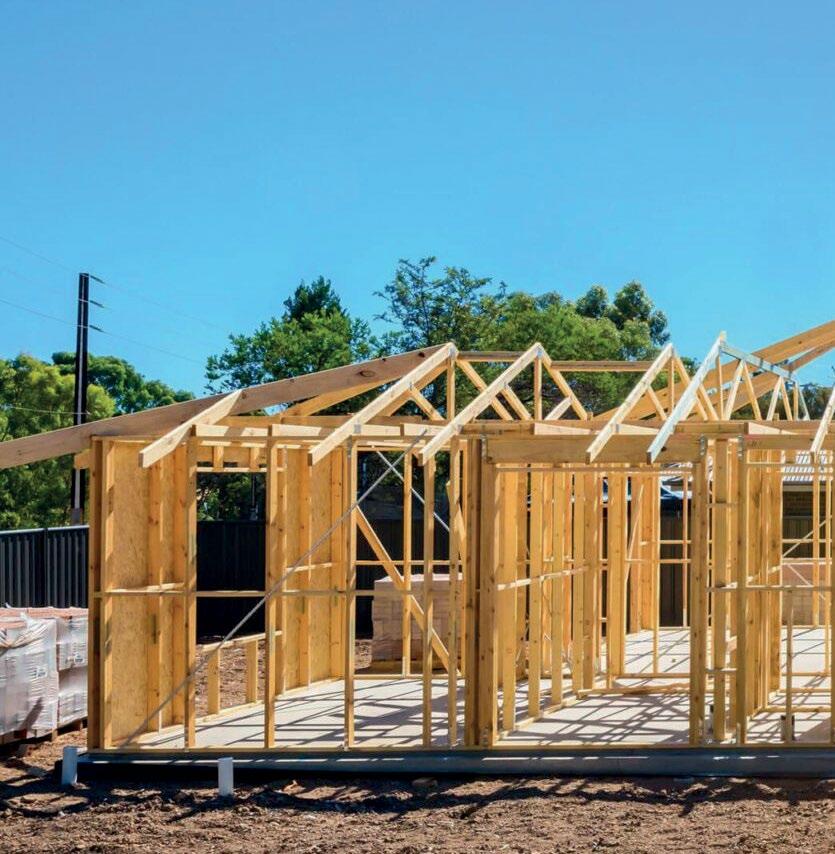
Remove the following note to B1P1
Note: The requirement in B1P1(2)(a) to consider, for a Class 7b building, an additional notional permanent roof load of not less than 0.15 kPa to support the addition of solar photovoltaic panels does not take effect until 1 October 2023.
Remove the following note to B1D3
Note: B1D3(a)(iv) does not take effect until 1 October 2023.
Remove the following note to the introduction of G7
Note: Part G7 Livable housing design does not take effect until 1 October 2023.
Replace D3D28(4)(b) with (b) For a self-closing door –FIRE SAFETY DOOR DO NOT OBSTRUCT DO NOT KEEP OPEN
Remove the following note to the Introduction of Part H8
Note: Part H8 Livable housing design does not take effect until 1 October 2023.
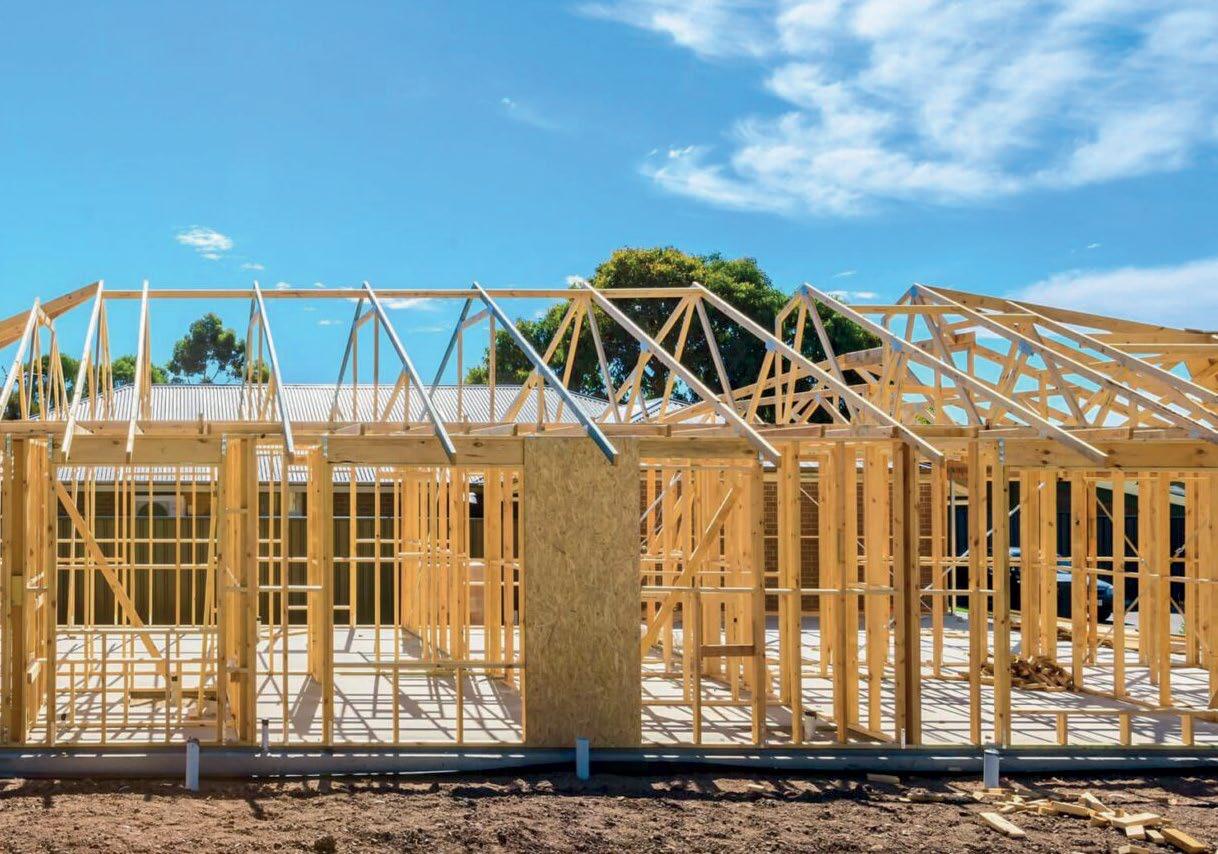
Refer to Table 3.2.1
Replace the maximum embankment slope ratio, angle of batter of 3:3 for Stable rock (Class A) with 2:3
Remove the following note for 6.3.9 after Table 6.3.9c
Note: Clause 3.4.4.4 and Table 3.4.4.7 from NCC Volume Two 2019 (Amendment 1) may be used in place of 6.3.9 and Tables 6.3.9a, 6.3.9b and 6.3.9c until 1 May 2024.
Replace the following formula in 13.3.2(1)(b) with regards to external glazing calculator:
A copy of NCC 2022 Amendment 1 can be accessed on the Australian Building Codes Board website
View our website for more information and resources.
Master Builders
Victoria (MBV) will keep members informed should the ABCB announce any future changes
MBV members are welcome to contact our MBV Technical and Building Regulations Team on (03) 9411 4555 or via email at techandreg@mbav.com.au for anything relating to this article or other technical matters.
The information contained within this article is general nature. It is not intended to substitute professional advice and should not be relied upon as such. We encourage members to seek personalised advice where appropriate.
When I first stepped into my role at Master Builders Victoria (MBV) six months ago, I was quickly struck by how unique and complex the Employment and Industrial Relations (EIR) landscape is, especially within the building and construction industry. With no trade background, I had to get up to speed fast – not just with the technicalities of awards and agreements, but also with how easily misunderstandings in this space can lead to underpayments, compliance breaches, or even legal disputes. If you’re a small business owner, manager, or otherwise, and have employees in this industry, this article is for you – I’m sharing what I’ve learned so far, so you don’t have to learn the hard way.
One of my earliest challenges was understanding the distinction between joiners and carpenters – not just from a trade perspective, but from an industrial relations standpoint. Surprisingly, two modern awards can cover the same trade, depending on the nature and location of the work. For reference, a ‘modern award’ is a legal document that sets the minimum terms and conditions for an occupation or an industry.
The Building and Construction General On-Site Award 2020 (BCGOS) applies to employees who perform operational work on-site, such as a construction project. In contrast, the Joinery and Building Trades Award 2020 typically covers employees who perform joinery and prefabrication work off-site, such as in a factory or workshop setting. This distinction is crucial for determining the applicable terms and conditions of employment.
Coming from a legal academic background, I was surprised to learn that the BCGOS Award includes its own redundancy entitlements – which are distinct from the National Employment Standards (NES) under the Fair Work Act.
For example, the BCGOS Award defines redundancy broadly:

“Redundancy means a situation where an employee ceases to be employed by an employer to whom this award applies, other than for reasons of misconduct or refusal of duty.”
This broad definition means that if an employee resigns from their employment, they are still entitled to a redundancy payment set by the BCGOS Award – a concept that challenges the common understanding of a redundancy.
Another feature unique to the BCGOS Award is the distinction between daily hire and weekly hire employment. You may be asking, what are these types of employment? In short, both are full-time modes of employment. The difference is in the notice period.
Daily hire employees must receive and provide a day’s notice on termination. This explains the daily nature of the engagement. Daily hire engagements may be more suitable where the work is uncertain, irregular, or tied to project milestones.
Weekly hire employees receive notice in accordance with the NES. The NES sets notice in terms of weeks, depending
on the length of service and age of an employee. In this sense, there is a weekly basis to notice – which most people are familiar with.
Importantly, daily hire employees are not casuals. They still accrue entitlements like annual leave and personal leave, just like their weekly hire counterparts – a point that is often misunderstood in practice.
Another notable issue that has come up over the past six months is an employer’s obligations in relation to apprentice schooling. Under the BCGOS Award, apprentices must be allowed to attend off-the-job training in accordance with their training contract, without loss of pay.
The Award also requires employers to reimburse apprentices for Registered Training Organisation (RTO) fees and prescribed textbooks, unless the employer has paid for them directly to the RTO. This must happen within six months of the apprenticeship (or stage) starting, or within three months of training commencing – whichever is later – as long as the apprentice is making satisfactory progress.
A common issue I’ve come across is employers feeling unsure about how to handle performance management, misconduct, or workplace expectations within the limits of legal processes. The reality is, many of these situations are best approached by talking things through early and openly with

employees. The law doesn’t always offer a quick fix – but open dialogue often leads to more practical and effective solutions.
Another adjustment has been understanding the union presence in the commercial side of the industry. It’s far more active, brazen and difficult to navigate than I expected based on my studies. Balancing the law and the industrial reality in our industry is an art that not many people appreciate.
The building and construction industry is filled with unique employment and industrial relations challenges – thankfully, MBV is here to assist. From award coverage and apprentice entitlements to navigating interactions with unions, being informed is essential to staying compliant and avoiding costly mistakes. If you would like further information you can speak to myself and my colleagues in the MBV EIR team on (03) 9411 4555.
Please be aware this article contains general information and is not a substitute for legal or other professional advice.
I’m sharing what I’ve learned so far, so you don’t have to learn the hard way.
See more from the MBV EIR Team including guides and other resources
ARTICLE AUTHOR MBV Graduate Employment and Industrial Relations Advisor: Amber Cambareri

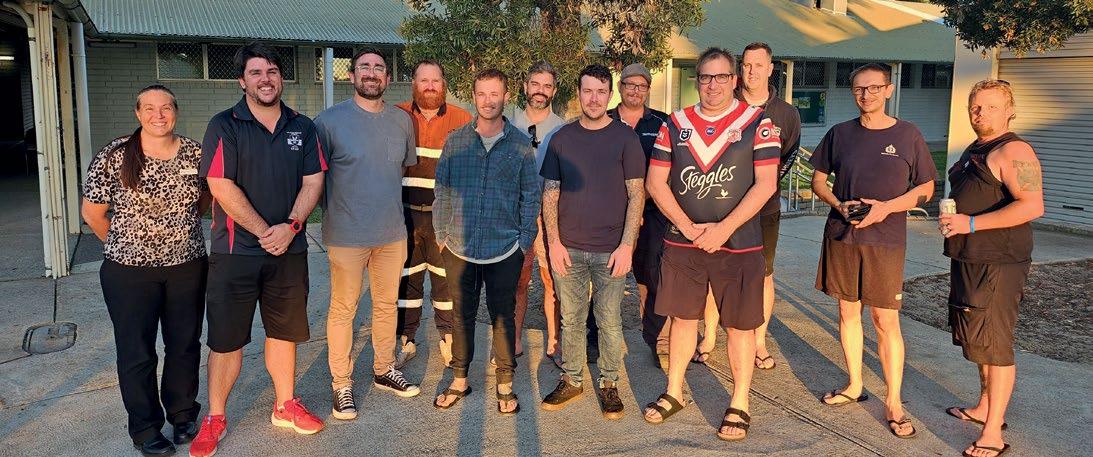
I didn’t realise how much I needed this. I book it into my calendar every month.
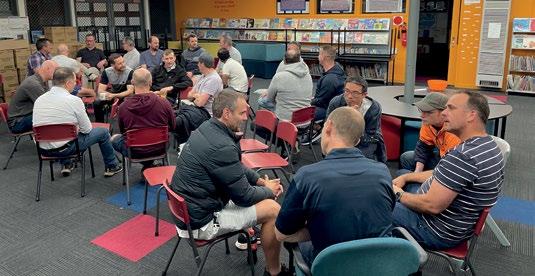
That’s what we hear time and time again from dads who join The Fathering Project’s Dads Group –whether it be in person or online.
Being a dad is one of the most rewarding jobs there is, but it can also be one of the most isolating, especially in male-dominated industries like building and construction, where long hours and tough schedules leave little time for reflection or connection.
The Fathering Project offers Dads Groups and Virtual Dads Groups that provide a space for fathers to come together, share, listen, and learn how to be the best influence they can be for their children.
These aren’t your average parenting sessions. There’s no judgement, no lectures – just real conversations, support, and tools that make a difference.
Our groups are designed for working dads who want to:
• Feel more confident in their parenting
• Connect with other blokes facing similar challenges
• Strengthen their relationship with their kids
• Be present, even during the busy times
Whether on-site or after hours, dads can join in-person groups hosted through their child’s school, in their community, or tap into virtual groups run monthly by The Fathering Project team, making it accessible no matter where they’re based or how packed their calendar is.
If your workplace values wellbeing, family, and mental health, share this opportunity with the fathers on your
team. Encourage them to join a Dads Group, or, consider hosting a Lunch and Learn workshop to support your team.
You might be surprised by how many would appreciate the support – and how it positively ripples into your workplace culture.
Scan the QR code to learn more or join a group today:

It could be the most valuable tool you ever hand over to a father.

Local charity Horizon Committee has donated $50,000 to Echuca Regional Health (ERH) following its Great Postie Bike Adventure event.
The inaugural event saw 40 riders travel to Tasmania for a 1,300km round trip over five days. Participants came from all across Australia, from Victoria, New South Wales, Tasmania, Queensland, Western Australia and South Australia. This year, the event raised more than $100,000, which was split and donated to the ERH and the Hobart WP Holman Clinic Trust. Event Coordinator Dick Phillips said the event was not only about raising money.
“The ride, apart from raising money, is also an opportunity to promote cancer awareness ... it’s about promoting the services we have available through the ERH and of course, the Holman clinic,” he said.
The Horizon Committee has been involved in fundraising for cancer support services since 2004. The group has donated more than $2.6M through other fundraising events, including The Murray Charity Meander, EchucaMoama’s Biggest Ever Blokes Lunch and the Little Blue Towels project. ERH Executive Director of Community Services, Cynthia Robins said the funds raised through the Postie Bike Adventure would support ERH’s wellbeing services. “ERH sincerely appreciates the continued support of the Horizon Committee,” she said.
“This year’s Postie Bike Ride donation will continue to directly support ERH’s Primary Mental Health and Wellbeing initiative, helping to build a brighter, mentally healthier future for our beloved community.” Mr Phillips added that the
event would not have been possible without the help of local supporters.
“We can’t thank our support crew and event partners enough and special thanks must go to Moama Bowling Club and Echuca Mazda — without their ongoing help it would be difficult to make such an event happen,” he said.
Plans for next year’s three-day Great Postie Bike Adventure are well under way, with the event to be held in Warragul and the Gippsland region.
For further information about the 2026 event, contact event Dick Phillips on 0458 802 211 or by email at dp.echuca@ bigpond.com Alternatively, people can contact Darren Stephenson on 0417 318 856 or Hayley Lawton on 0408 100 545.
ARTICLE AUTHOR

Riverine Herald: Lua Ikenasio
Thank you to our regional MBV members from Echuca for their participation, and to Bourke Builders and Dixon Builders for sharing.


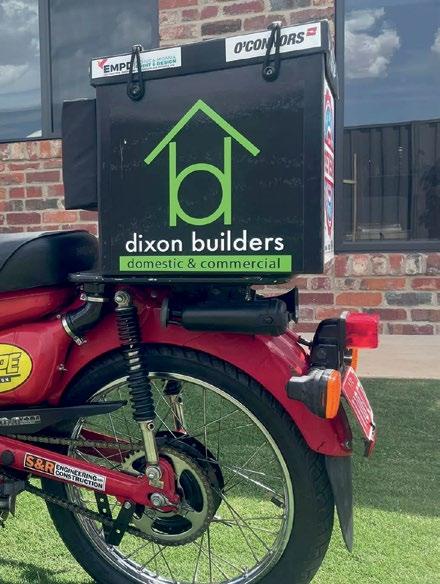

If you’re an apprentice or student looking to build your career in the building and construction industry, we invite you to become a Master Builders Victoria student member. Membership helps with generating career opportunities, networking and keeping up-to-date with the latest industry news and developments.
A MBV student membership offers multiple, exclusive benefits including:
The opportunity to join MBV’s network of building and construction professionals, along with thousands of industry peers, businesses, trainers and potential employers
The reputational power of the MBV brand, helping to position yourself as an apprentice or employee of choice
Exclusive discounts on expertly delivered industry skills training
An exclusive subscription to MBV Communications, including magazines, newsletters, industry updates and more
Special offers and discounts on MBV online shop products, such as branded clothing, PPE, publications, etc
Exclusive discounts on tickets to attend MBV events


MBV Student Membership regular price = $100 (excl. GST) per year (a small investment to make to support your career)
To take up this offer or for more information, contact our team on 03 9411 4555 or e-mail MBassist@mbav.com.au
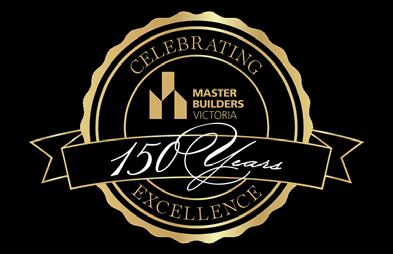
We can help! Underpinning will help stabilise the foundations of your building and reduce further damage.
Clay soil can be one the issues found to be causing cracking of brickwork or plaster interior walls. In some circumstances plumbing explanatory’s are required to determine if
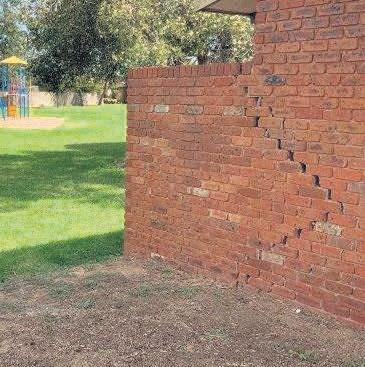


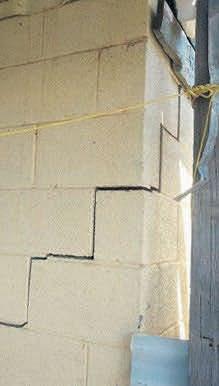
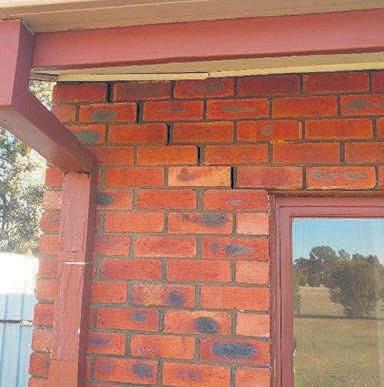
Like mortar is to brick, cables are to electricity and walls are to your roof, we are your link to home improvements.
Experts in underpinning, hydro excavation, new homes, renovations, extensions & permits.




It’s hard to believe it’s been ten years since Cam Wood and I (Andy George) took the leap and launched Link Building Systems. Back then, we were full of enthusiasm and optimism, ready to take on the world. Like many new business owners, that early excitement quickly gave way to the reality of long hours, complex logistics, and the most important lesson of all—cash flow is king.
When we first set out, our work focused on insurance repairs, underpinning, restumping, and renovations. The first three years were a grind. We worked hard, made mistakes, and learned a lot. At the three-year mark, we found ourselves at a crossroads. We had lost a few good team members, and after conducting several exit interviews, it became clear that we needed to rethink how we ran the business. Our management structure wasn’t working, and neither was our mix of jobs. It was time for a tough conversation and some even tougher decisions.
Someone once told me that making a hard business decision is like ripping off a Band-Aid—the thought of it is worse than the act itself. They were right. We restructured management,
dropped private restumping jobs that were taking more energy than they were worth, and set our sights on building a more focused and sustainable operation. We brought in a business coach and started working on goals, metrics, and accountability. It wasn’t an overnight transformation, but we gradually stopped spinning our wheels and started gaining traction. We began investing in the right tools, vehicles, and equipment. One of the most valuable exercises we adopted during this period was an annual vision-building day. Once a year, we would step out of the day-to-day operations and map out our 1-year, 5-year, and 10-year goals. These sessions gave us clarity, purpose, and a roadmap we could track quarterly.
A big contributor to our success has also been having the right accountant in our corner. Our accountant’s advice has always been grounded and practical. Whenever I’d ask, “Can we afford this?” she would respond with three simple questions: “Do you need it? Will it make you money? Can you afford it?” If we could confidently answer yes to all three, we moved forward. That kind of clear thinking helped us grow without overextending ourselves.
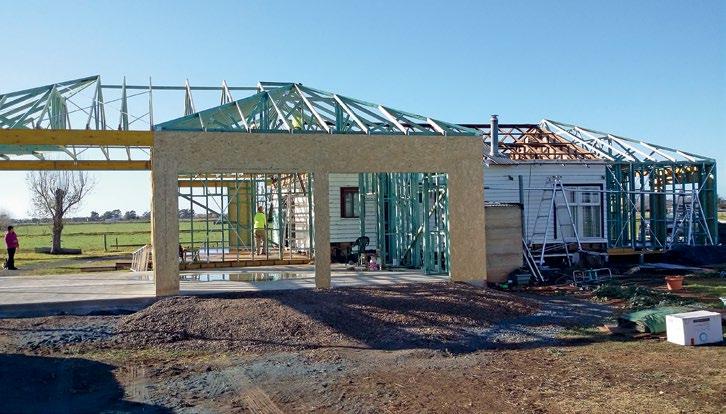
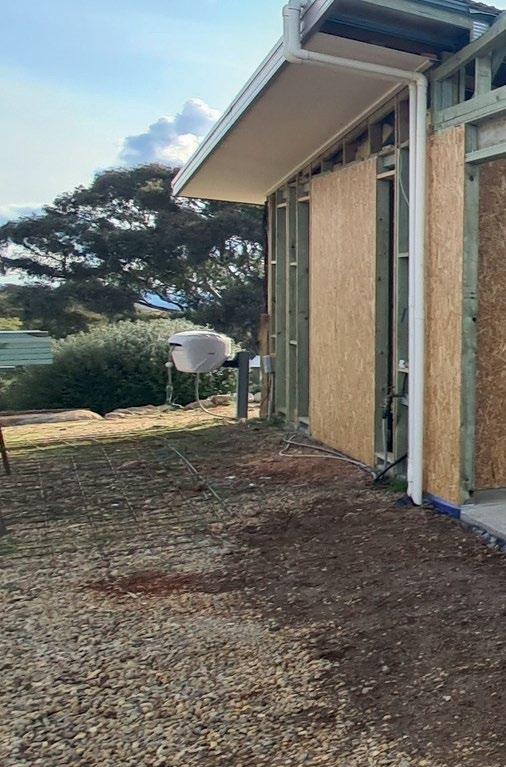
Years four to six were about refining and scaling. We deepened our experience in the insurance sector, strengthened relationships with assessors, and positioned ourselves as reliable problem-solvers. Our underpinning division became a well-oiled machine, complete with documented processes and scripts to ensure consistency and quality. We even had the opportunity to build our first new home—a highend custom project that our team absolutely nailed.
Then came 2022 and the devastating Victorian floods. Like many others, I found myself quite literally underwater. But thanks to the solid foundation we’d built over the years, we were ready. We were proud to be part of the rebuilding effort, taking on complete flood strip-outs and rebuilds. Working with homeowners who had lost everything was emotional, but also incredibly rewarding. Our team approached every job with empathy and care—adding a personal touch that made a real difference during a difficult time. While the business has grown, so have our families. Cam now has three kids, and I have two. Balancing work and family isn’t always easy—some weeks we get it right, others not so much—but we both know that the effort we have put in will benefit our families and future
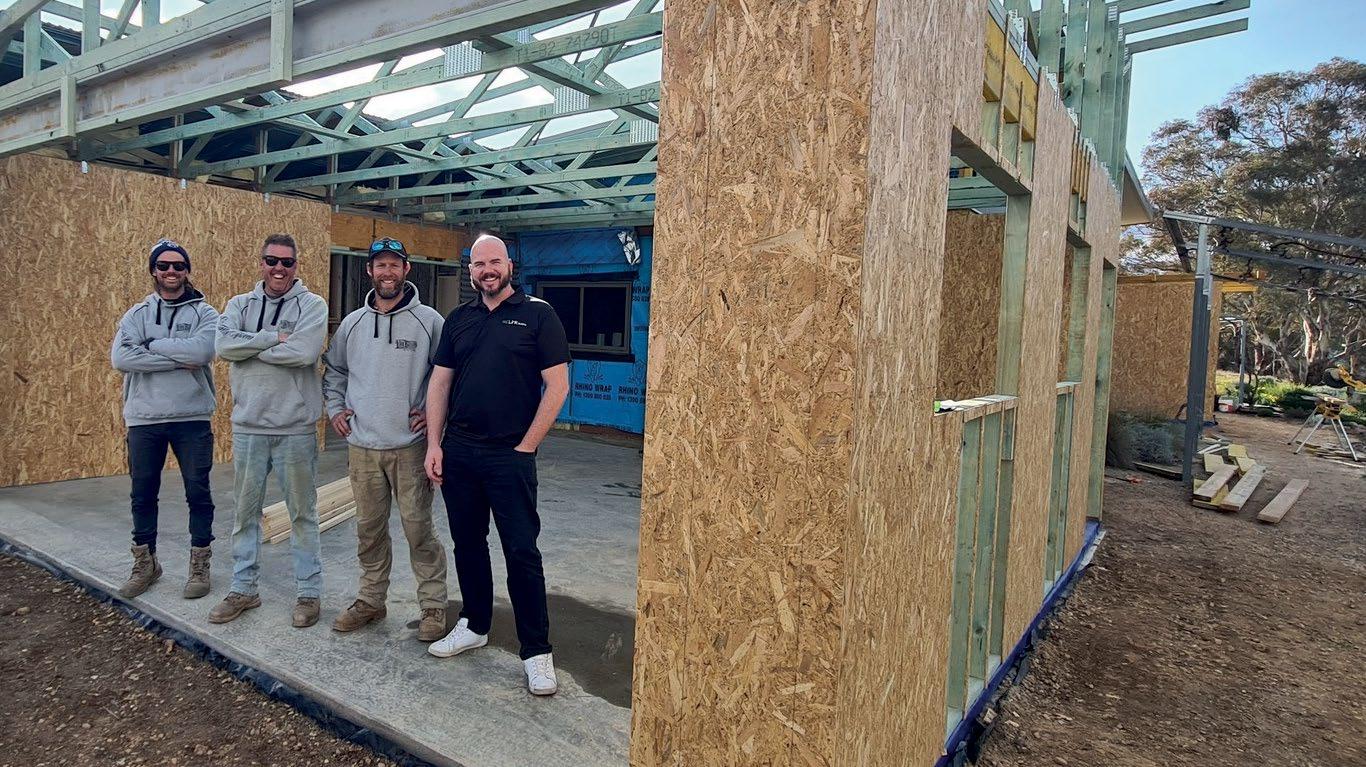
generations. Who knows, maybe one day our kids will join the team or even take over. Or maybe they’ll navigate their own path. Time will tell.
We’re incredibly proud of the culture we’ve built at Link Building Systems. Our team is the heart of the business. Many of them have been with us through the highs and lows, and their loyalty and hard work have not gone unnoticed. Some are now eligible for long service leave—a milestone that speaks volumes about the environment we’ve created together.
Ten years ago, we started with a dream and a toolbox. Today, we have built something solid—something we’re proud of. Here’s to the next chapter. Cheers to 10 years, and here’s to 10 more!
Visit their website to see more about Link Building Systems
ARTICLE AUTHOR

Andy George

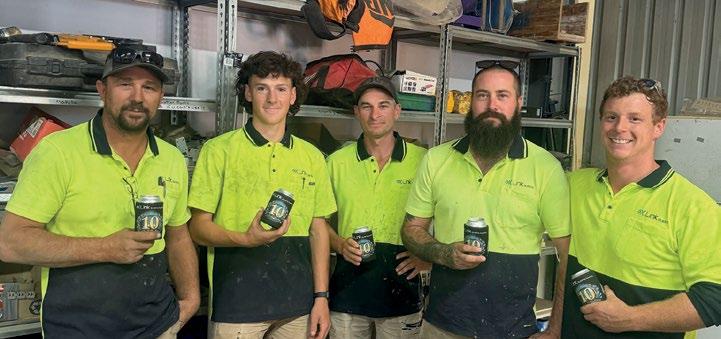
Master Builders Victoria has partnered with Solar Victoria in conjunction with the Victorian State Government to make available online training that you can complete in your own time. The training consists of 4 one-hour modules designed to help you build better, more comfortable, energy efficient homes.
The topics covered in this training include;
• National Construction Code (NCC) and Net Zero – learn about recent changes and be prepared for the future.
• Passive Solar Design – design tips to maximise the star rating.
• Window Technology – what to look for in windows to maximise the star rating.
• Insulation, Pliable Membranes, Wraps and Tapes – what to look for in terms of product compliance and installation tips.
• Thermal Bridging and Thermal Breaks – how these impact on the comfort of the home.
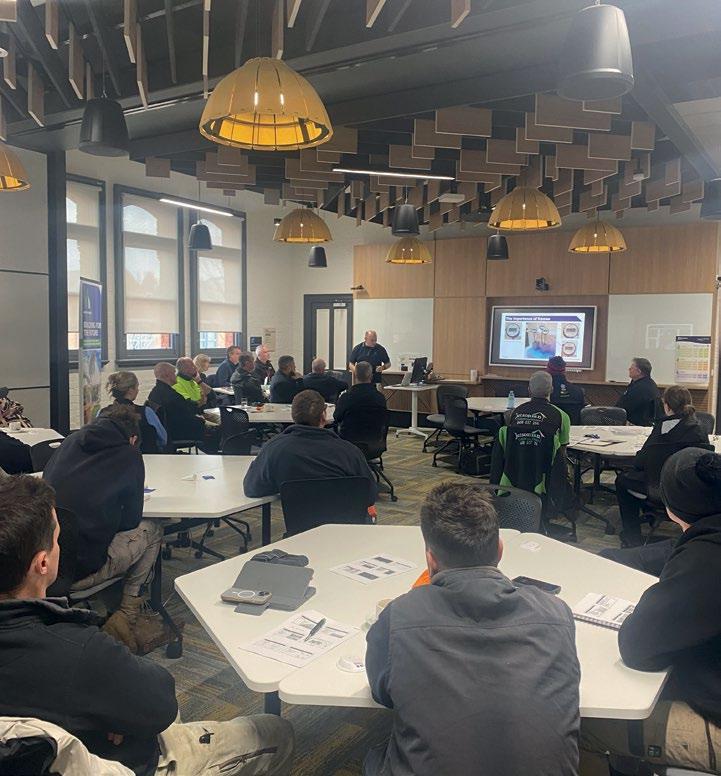
• Vapour, Condensation and Mould – a look at the causes and how to avoid problems.
• Indoor Air Quality – impacts on indoor air quality and how to avoid any problems.
• Ventilation and Ventilation Systems – when to consider using them, what are the benefits and what to look for.
• Achieving Air and Thermal Management – tips on reducing drafts and improving occupant thermal comfort.
• Whole of Home – learn about the inclusion of a number of appliances and their energy efficiency as a part of the NatHERS rating.
• Electrification – what appliances to use and what to look for.
• Energy Efficient Appliance Selection (including information on available rebates)
• Photovoltaics, Batteries and EV Charging (including information on available rebates)
Participants who complete these training modules will earn CPD points and receive a Certificate of Completion.
This initiative is funded by Solar Victoria as part of the Training and Workforce Development program.



The future looks bright for a more inclusive and diverse golfing community at MBAV & Exchange Golf Club.

What began as an initiative by the MBAV and Exchange Golf Club to promote greater inclusivity has blossomed into a successful program encouraging women from the building and construction industry to take up golf. Ten months since its inception, the first group of eight women who were new to the sport, have now completed their training program and are set to become regular players in the club’s event calendar. The program was proudly sponsored by Incolink, whose commitment to fostering gender diversity in traditionally male-dominated spaces such as building and construction extended to the green. With more women entering all facets of the industry, this initiative provides a healthy social outlet that aligns with the evolving landscape of our sector.
Golf, known for its blend of competition and social interaction, provides an ideal environment for networking and relaxation. The MBAV & Exchange Golf Club hosts regular stableford competitions across three divisions, along with a Corporate Cup team event—offering a space where players of all skill levels can enjoy the game together. The program aimed not only to build skills but also to ensure new players could comfortably take part in these established club traditions.
Wayne Berger, Secretary of MBAV & Exchange Golf Club and the driving force behind the initiative, is thrilled with the outcomes and grafeul for the support this program has received“without the support of Incolink this program would never have got off the ground. Their financial support enabled us to meet the costs of the training
program,” he noted. “We’re also grateful to Master Builders Victoria for their help not only with this initiative, but the ongoing support they render our golf club.”
With the first cohort now joining the monthly competitions, the future looks bright for a more inclusive and diverse golfing community at MBAV & Exchange Golf Club.
For more information or to join the program, please contact:
Wayne Berger
Secretary
MBAV & Exchange Golf Club
Ph: 0449 141 163
Master Builders Association of Victoria
Masterbuildersvic
Master Builders Association of Victoria
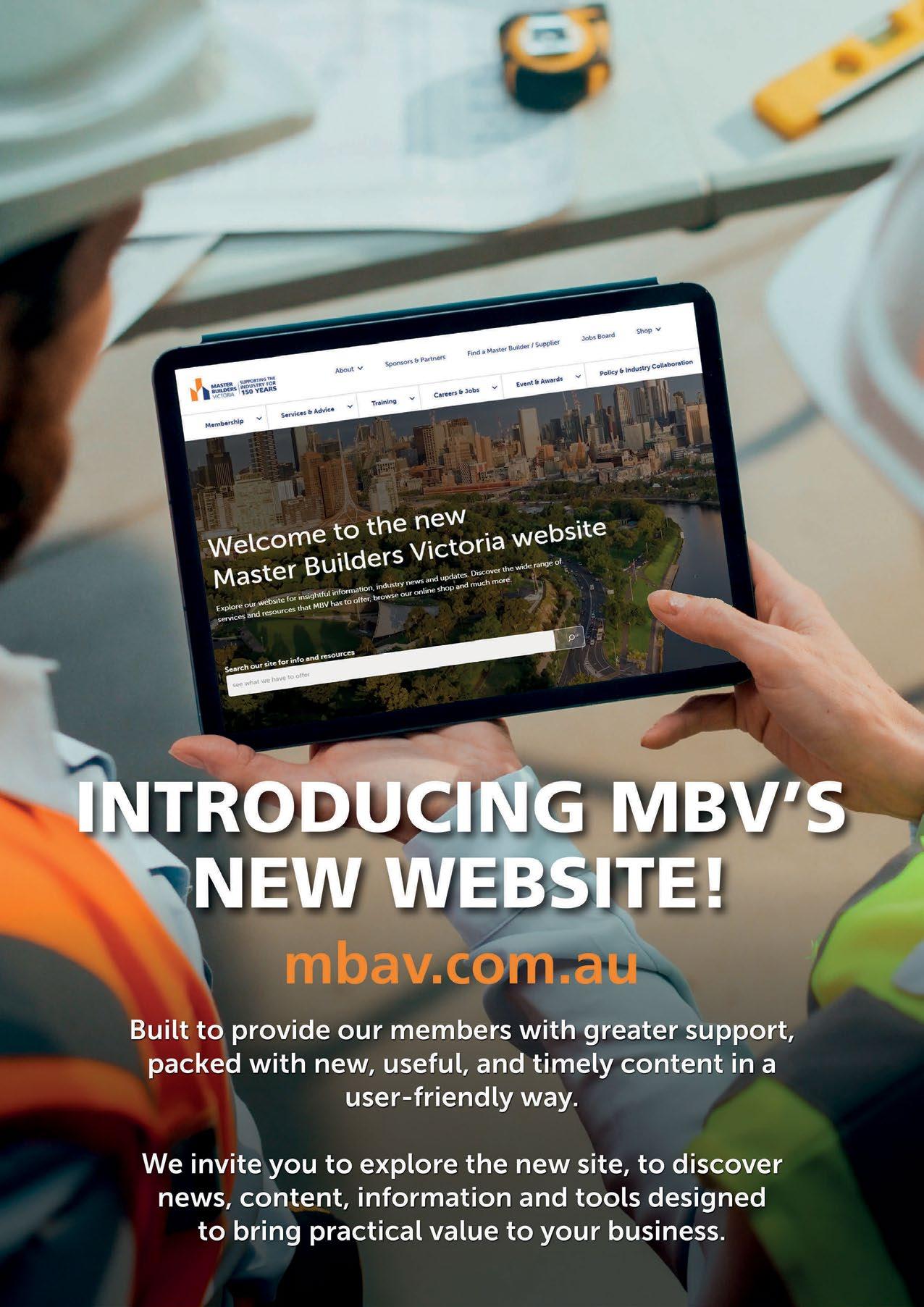
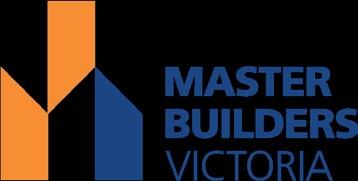
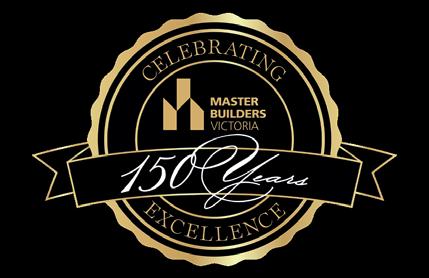
• Legal
• Occupational Health and Safety
• Employment and Industrial Relations
• Technical and Registration
• People and Culture
• Policy and Industry Collaboration
• Sustainability and Future Built Environments
• Expertly delivered industry skills training (at specially discounted rates)
• Discounted tickets to industry-leading events, webinars and workshops
•
• Access to exclusive member resources
• Subscription to MBV communications; keeping you up-to-date and informed
• Access to MBV eDocs (digital contracts) system
• Have your voice and interests represented through MBV’s advocacy work
• Eligibility to enter MBV’s prestigious Excellence Awards
• The reputational power of the MBV brand




Toyota Halo gives you insights to optimise your operations
Toyota Halo is your complete fleet management solution. It gives you oversight over vehicle health and location2, driver behaviour, logbooking and much more, all in a simple dashboard. Whether you have a few vehicles or a nationwide fleet, your business will benefit by accessing fleet insights from almost anywhere..
With Toyota Halo, your business can optimise its operations and boost its efficiency with oversight on your fleet's location, status and performance.
Ready to get the most out of your fleet with Toyota Halo?

1Subscription-based.